Public Pier — No Fishing License Required
It’s nothin’ fancy, but it will do
Sun is rising, day is new
Birds are singing a sinful tune
It’s nothin’ fancy, but it will do
It’s nothin’ fancy, roll out the folding chairs
Leave your worries over there
The lines in the water, there’s one for you
It’s nothin’ fancy, but it will do
I’ve been coming round here since 1962
and the boys are real friendly, and the ladies are too
Fishing’s slowed down, but the water’s still blue
It’s nothin’ fancy, but it will do
It’s nothin’ fancy, it’ll do.
Nothin’ Fancy—Gary Shiebler — The World’s Greatest Fishing Band
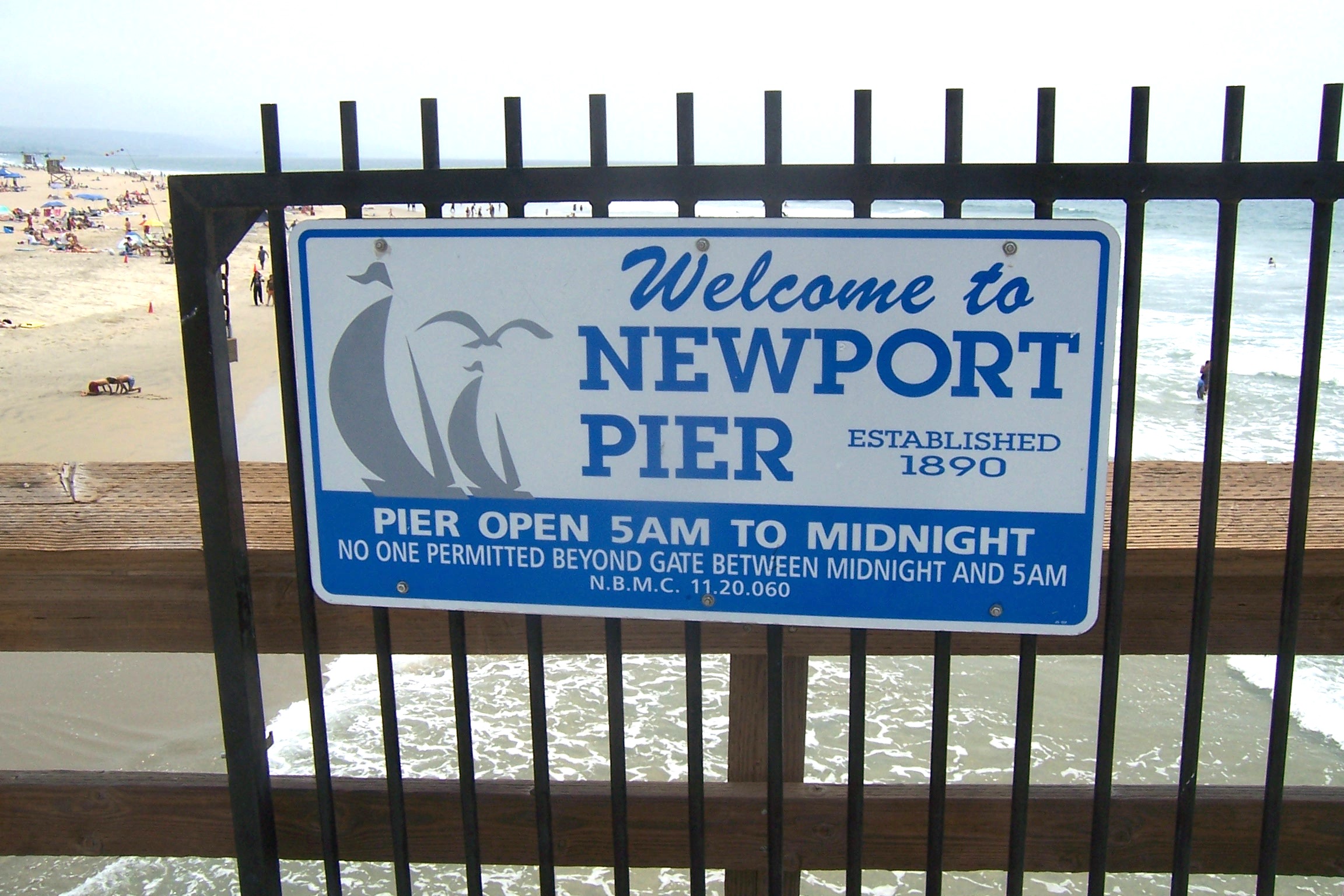
Every angler has his or her favorite spot and mine, until recently, was this old pier. It isn’t the longest of piers, fanciest pier, or even the prettiest. It no longer has either of the two bait and tackle shops that once graced McFadden Place nor the bait shop out at the end that carried live anchovies. And, many times, finding a parking space can be almost impossible. It doesn’t even rank among the top piers in my record book. Even worse for a true “pier rat,” it’s no longer an old wooden pier; it’s been modernized and spruced up; it now has a concrete surface instead of the wooden planks preferred by old fogy anglers like myself.
However, this is where I first became a regular on a pier, where I learned the basics of pier fishing, and where I developed a love of the piers. It’s also where I began a lifelong appreciation of the different fish to be caught on piers. Most important, it’s where I became a “pier rat,” a term I use with eternal affection. Newport rates 100% on the nostalgia meter for me and I’m a sappy kind of guy when it comes to the “good old days.”
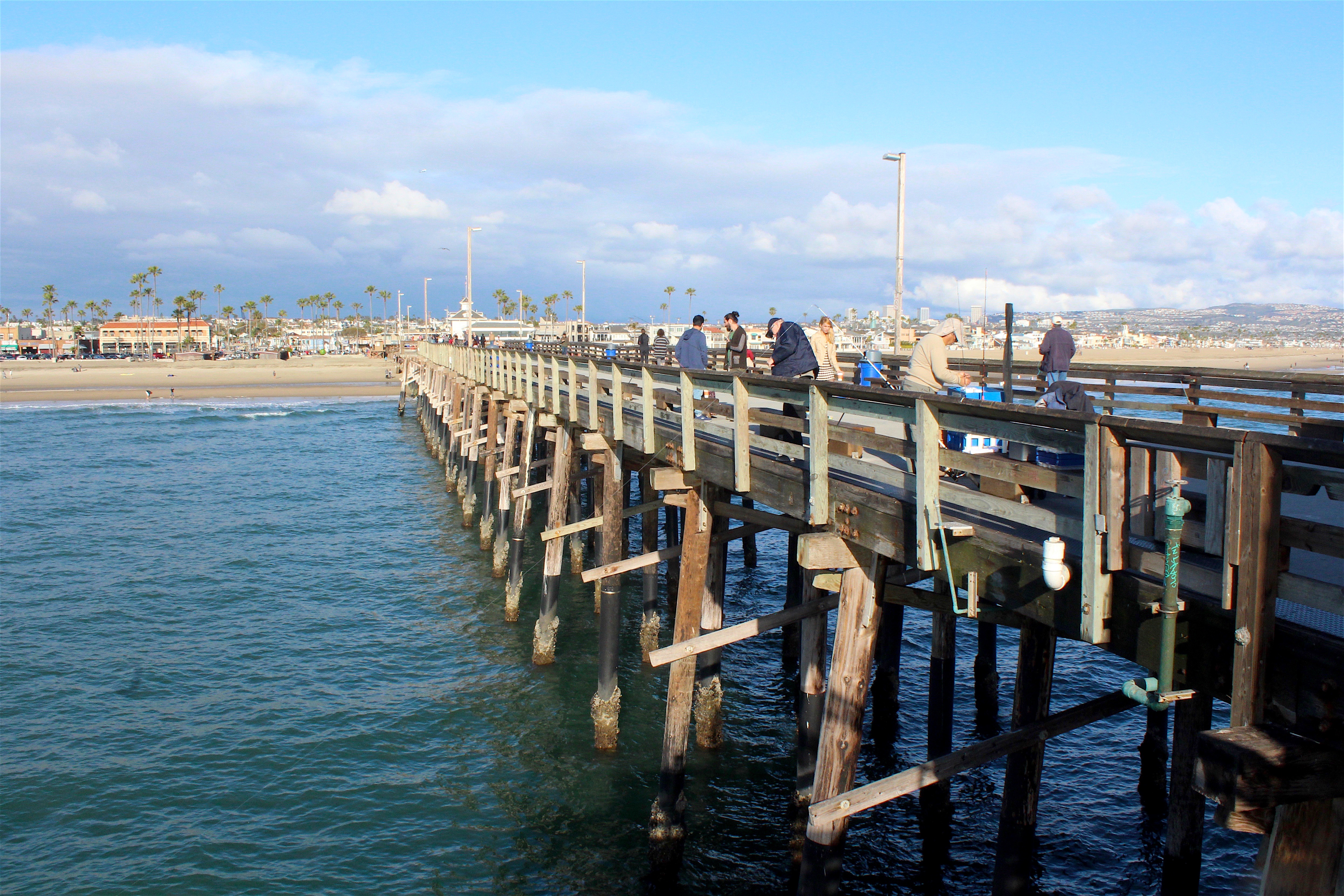
Like the song above, I’ve been coming to the (Newport) pier since 1962, the year my folks moved to Costa Mesa. My home was only a few miles from the pier, and it was a fairly short ride on my heavy, but trusty, old red Schwinn Corvette bike. I would get up at 4 A.M., grab some bait out of the freezer, tie down my bait bucket and tackle box, hang onto my rod, and take off on what was often a somewhat eerie, quiet journey through the fog.
I’d bike down the street past Newport Harbor High School, then zip down the steep cliff to the Pacific Coast Highway. If traffic was light (and it usually was at that time in the morning), I’d make a quick cut across the road, then pedal down the peninsula to the pier.
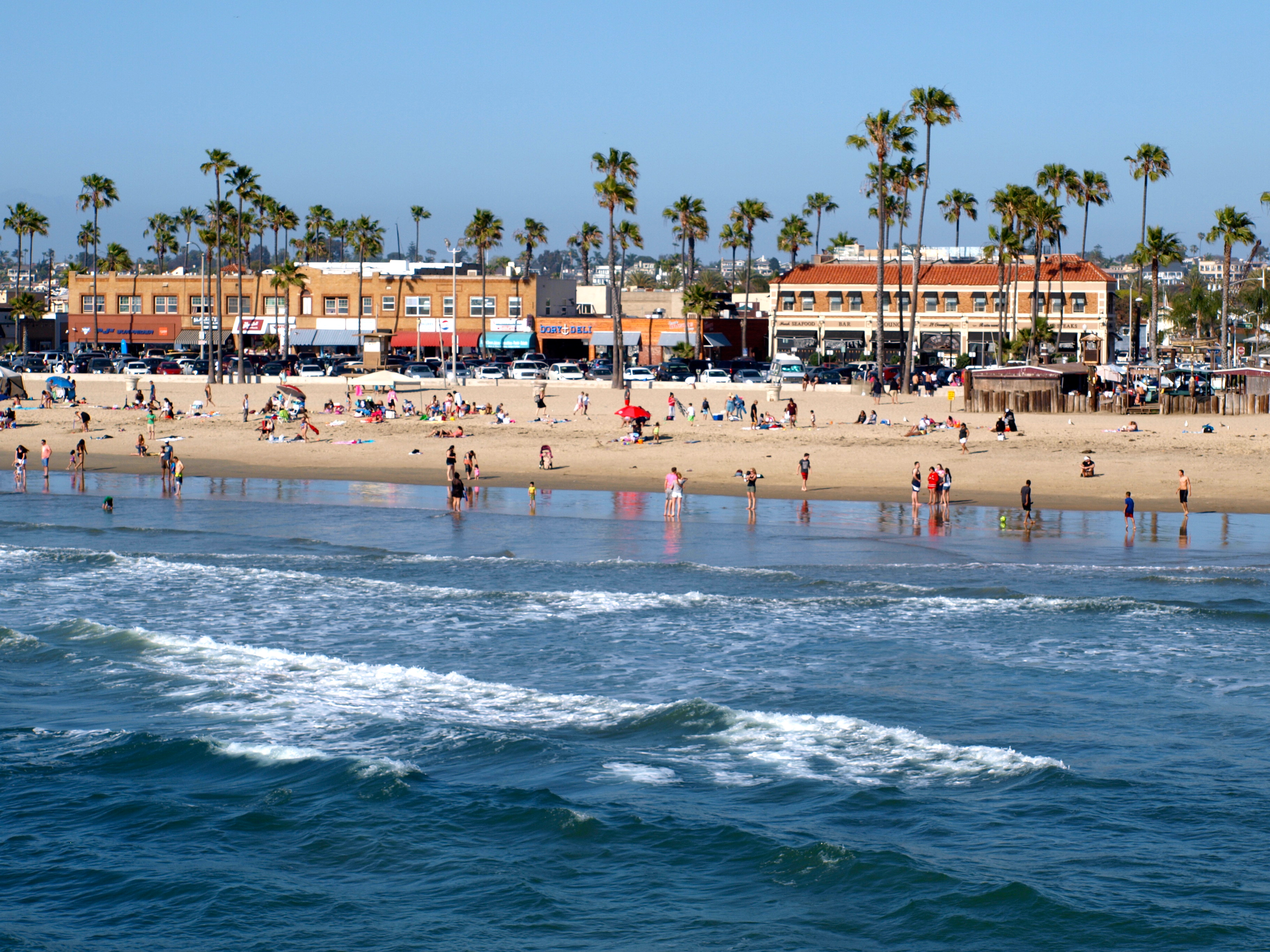
After locking my bike, I would hurry out to the far end of the pier and Mecca—the coveted northwest corner. Sometimes someone else would already have that spot—but generally it was one of the regulars. If so, it was only fair. I would often be soaked from the morning dew but I really didn’t care; it was simply a price one paid to catch some fish.
I did catch fish but it took some time before I became proficient. My first few trips saw an occasional small halibut or more often a sculpin (scorpionfish). It wasn’t until my seventh trip that I caught a decent-size fish, a barracuda, and it wasn’t until the tenth trip that I caught as many as ten fish. However, I soon began to get the hang of it and started to catch a variety of fish: bonito, mackerel, jack mackerel, queenfish, jacksmelt, perch and hake. I was finally becoming an angler and a “pier rat.”
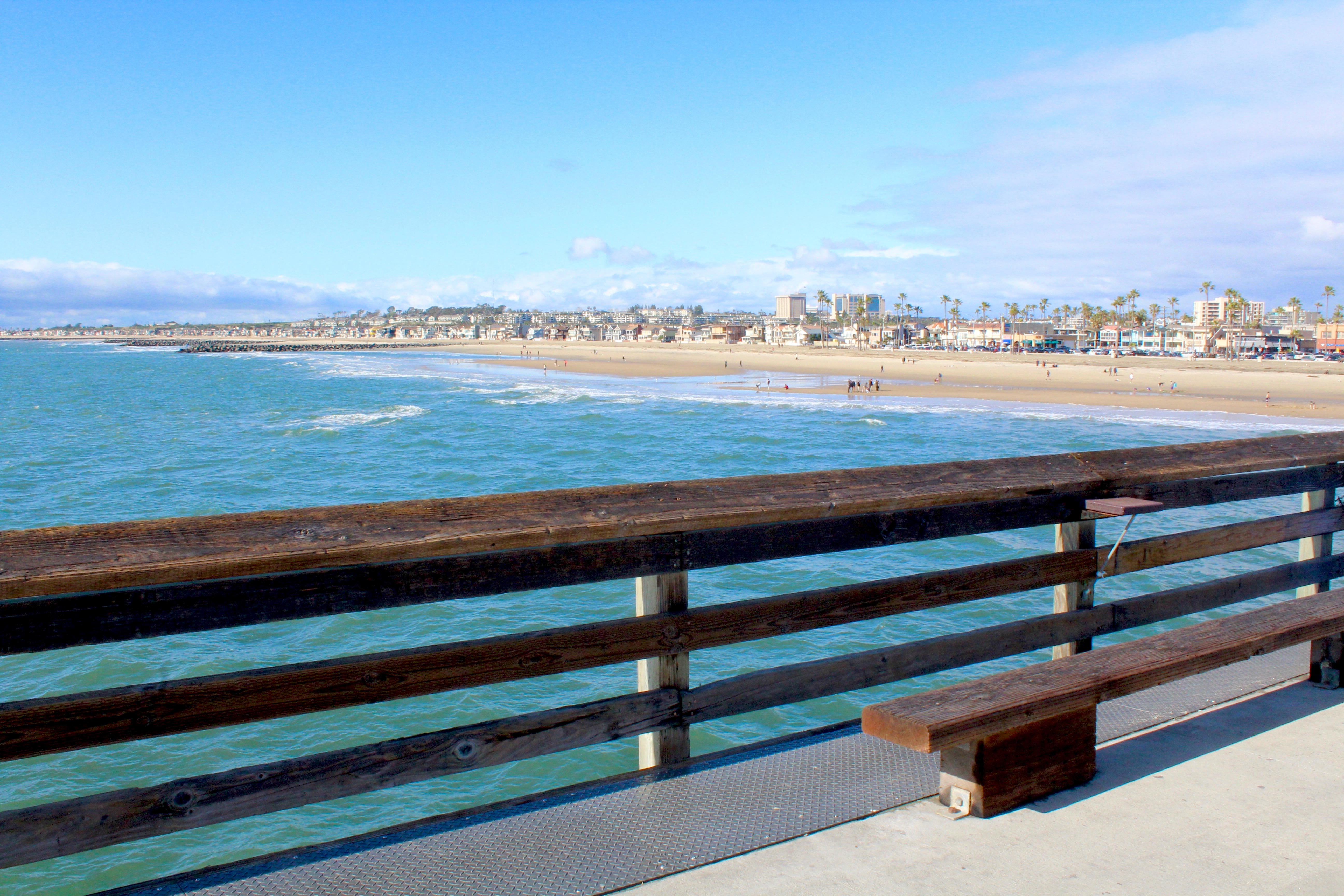
Looking west
At last, on an early September morning, I had my first “big day.” I had arrived, as usual, at the crack of dawn, and was fishing just down from the northwest corner. I was using squid for bait and had experienced very little early success. However, around 5:30 A.M., I had a strike and pulled in an ebony-colored fish—a type I had never caught before. The next cast yielded two more of these strange colored fish and I continued to catch fish, nearly every cast, for the next two hours. Strangely, only two other anglers were having similar success. Most anglers were fishless. Later, I found out the fish were sablefish, a deep-water fish more common to northern waters.
Upon cleaning the fish, I also found the reason for my success. The fish were stuffed with squid that were schooling in the waters near to the pier. Anglers who were using squid for bait, and there were only a few, were catching the fish. I caught 47 sablefish that day, but it was only a start. I continued to catch fish: large jacksmelt, Pacific mackerel and jack mackerel—77 fish in all. And, quite appropriately, I also caught a small squid. It was, mirabile dictu, one of the best days I ever had at the pier even though the fishing probably would have been considered poor for most of my fellow anglers that day. You just never know what is going to happen at Newport.
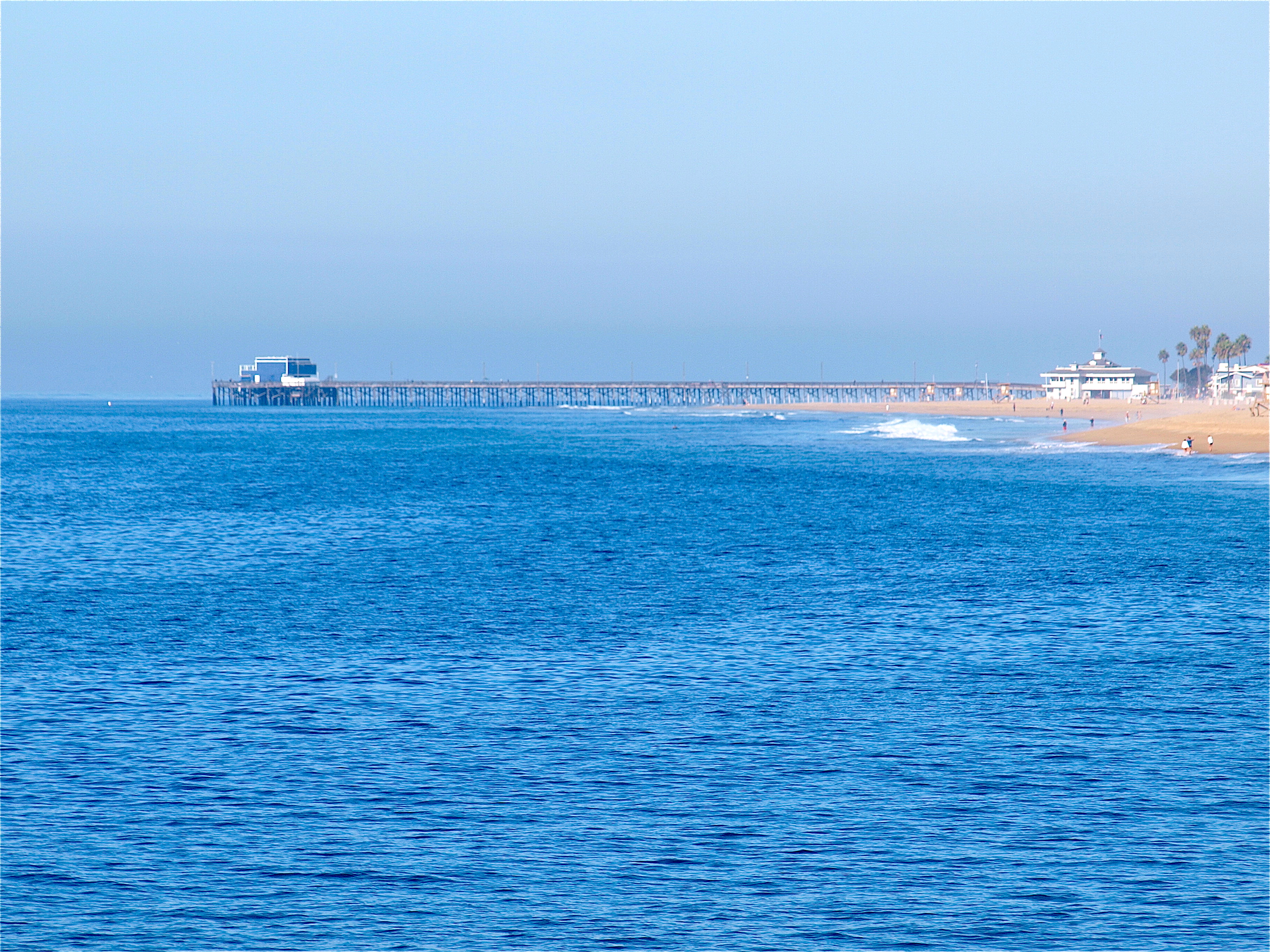
The Huntington Beach Pier sits to the west
Environment. At first glance, the Newport Pier doesn’t seem too different from most other California piers. The foot of the pier sits on a sandy beach—Newport Beach, which is one of the beaches that stretch down the Balboa Peninsula. The narrow peninsula itself heads southeast past the Balboa Pier before ending at the west jetty for Newport Bay.
On the other side of the narrow peninsula is Newport Bay and its islands—Lido Island and Balboa Island. The fish-rich waters of Newport Bay are a major fishing area in their own right (mainly bass, croakers and halibut) and are a major nursery ground for several types of fish.
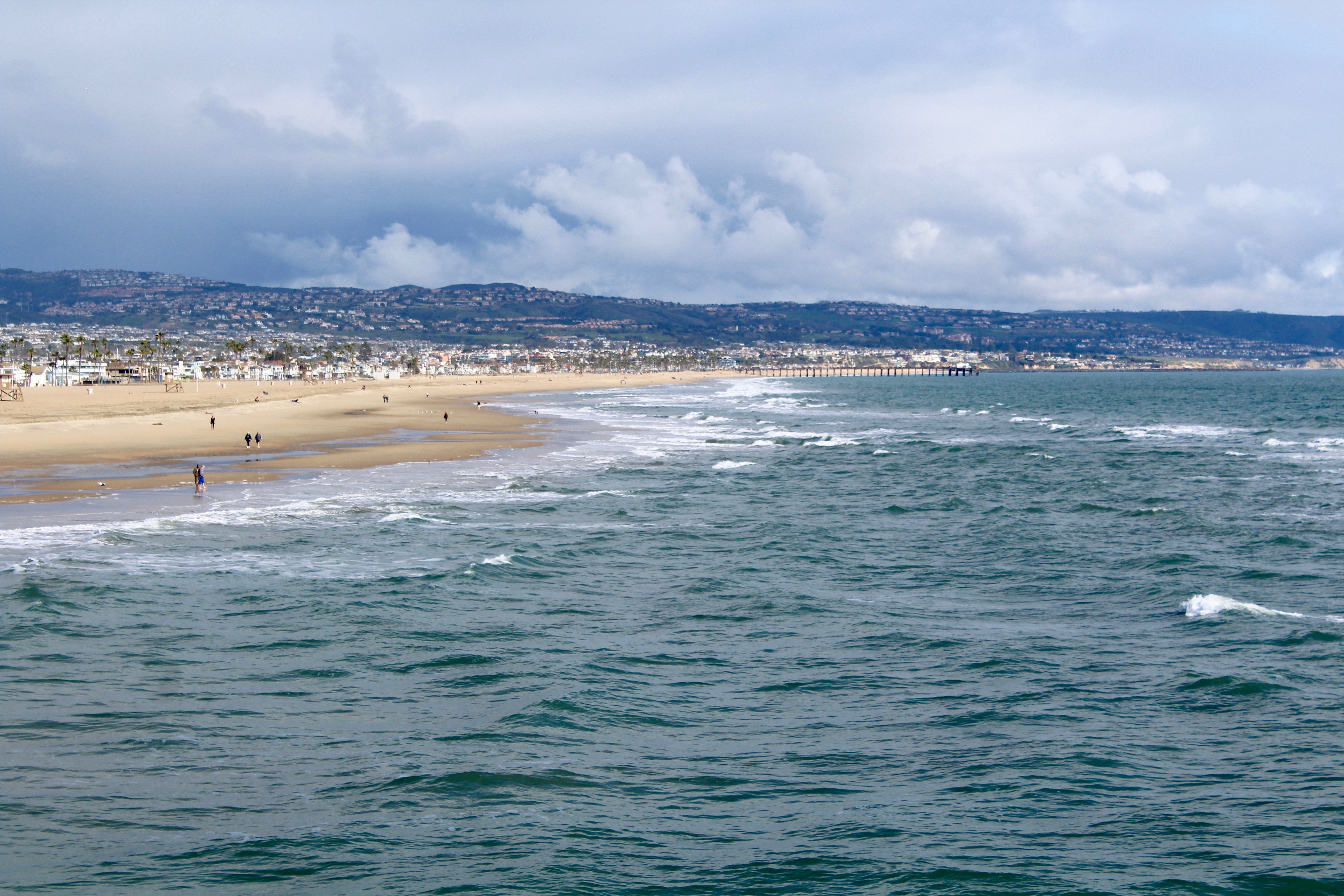
Looking east toward the Balboa Pier
As for the onshore environment, there is a reason why Newport is sometimes called zooport. Twenty-five years ago the city estimated more than 5,000 people visited the pier on an average summer day and I don’t think that number has gone down. One result: parking at McFadden Plaza at the foot of the pier can be almost impossible on weekends, holidays, and almost any summer day.
Sitting as it does straight down the highway from hot inland cities, Newport is seen as a “cool” beach town when the thermometer is hitting the high marks inland. And then there’s the sailing and the fishing! Newport is famous for its sailing craft and boats of every size and description call Newport home. Fishermen have a choice: deep-sea fishing on boats from Davey’s Locker and the Newport Landing, fishing in the bay for a plethora of species, or pier fishing from the Newport Pier and Balboa Pier.
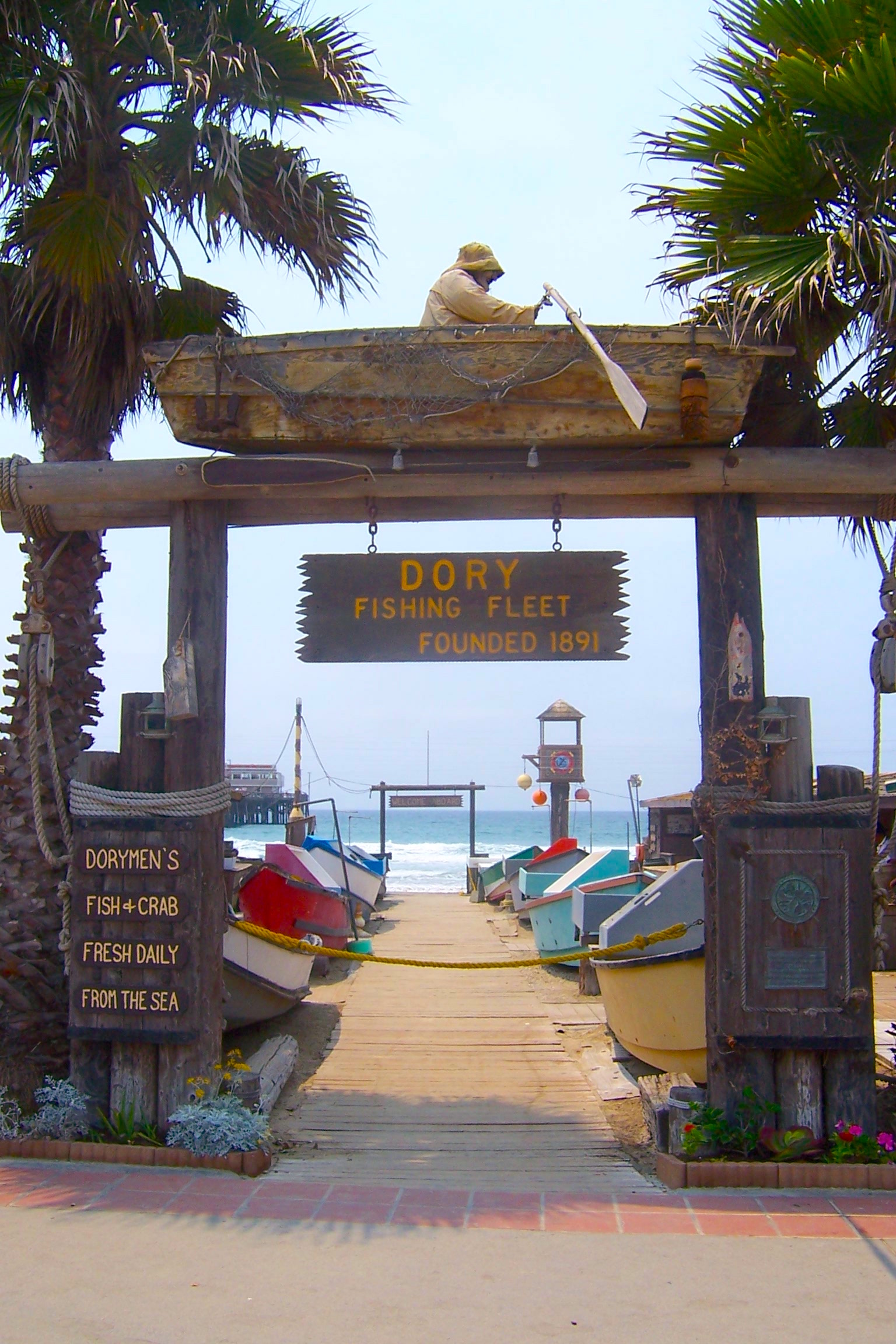
Another attraction for newcomers to this old pier is the iconic dory fishing fleet that sits on the sandy beach just north of the pier. It was founded by Portuguese fishermen in 1891 and is the last remaining fleet of its type in the nation. Today it’s a historic site and though there have been changes over the years, i.e., the dorymen use outboard motors today instead of rowing, and though ethnicities have changed, the daily routine is still much like it was more than 125 years ago.
The boats head out each morning around 4 a.m. to the deep-water beds, drop their lines into water several hundred feet deep, and hopefully catch some fish. Once the fish are pulled up from the depths it’s a full bore, hair blowing in the wind trip back to the pier and beach. The boats are pulled up on the sand and then they sell their fish, fresh from the sea, along “Rock Cod Lane.” Most of the fish are bottom-hugging rockfish (called rockcod)—the variety including thorneyhead, bocaccio, chilipepper, and other deep-water, reddish-colored rockfish. They also generally have two of my favorite fish—sculpin (actually scorpionfish) and sablefish also known as sea trout, black cod or butterfish (for their rich, oily, butter-like flavor). The sculpin can be cooked several ways while the sablefish (rare to most fish markets) are one of the best fish you can find if you like smoked fish.
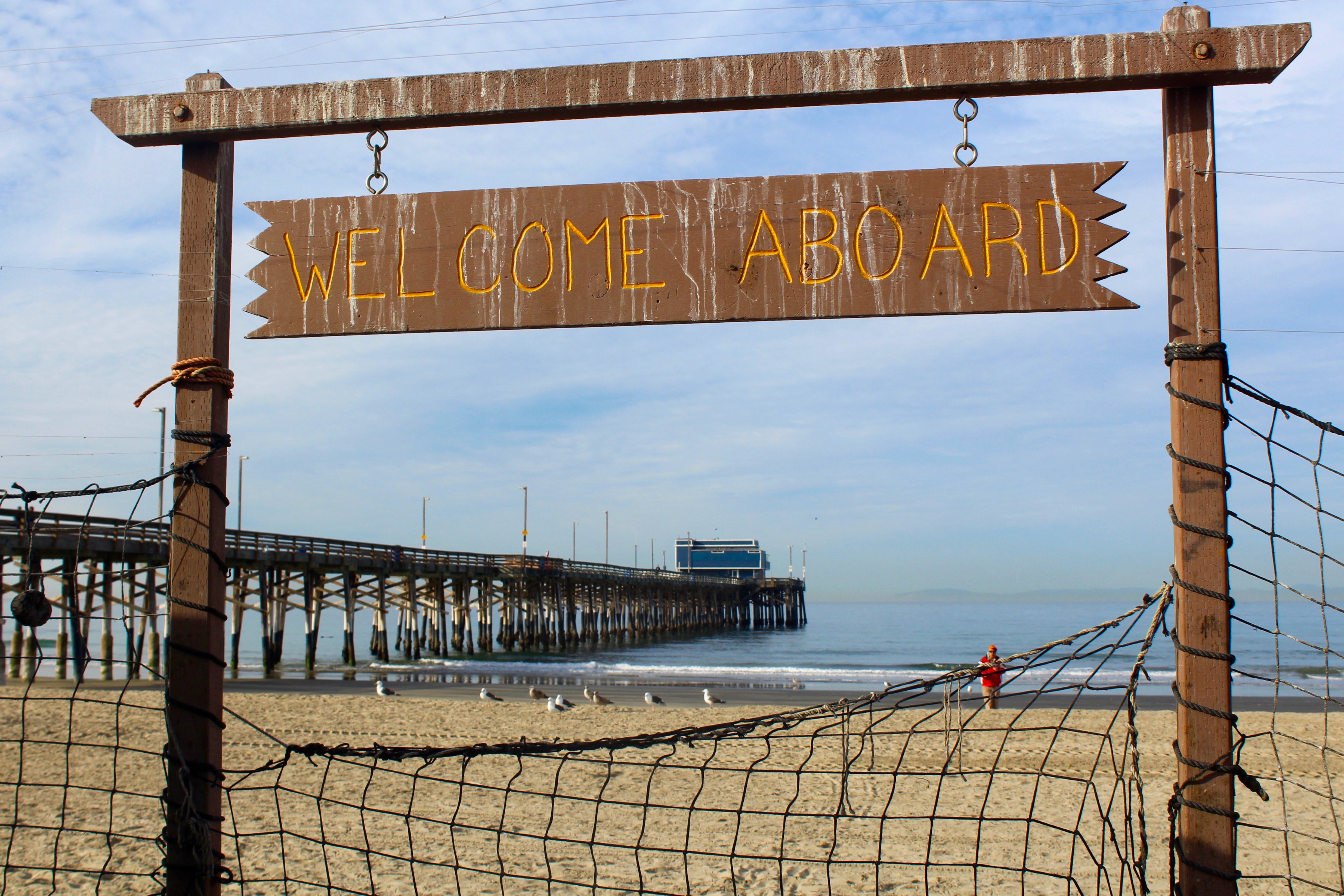
It’s a hard life for the fisherman, long hours, sometimes back braking work, and a constant struggle against changing weather conditions and the federal and state regulations that can seem to change as fast as the weather. But, it’s also a way of life few would give up. The dory fleet adds to the environment of the pier and, when pier anglers are unsuccessful, provides a ready market for fish to take home (although you often have to get there fairly early in the morning before the fish are gone). Their fleet’s motto is “Our fish is the freshest fish on Earth” and they might be right excepting for those fish freshly pulled in next door at the pier by the pier rats.
However, the Newport Pier isn’t like most of its fellow piers. It’s fairly unique due to the deep-water Newport Submarine Canyon. The pier itself is fairly short at 1,032 feet, and the water at the end is only about 30 feet deep, but from the end of the pier it’s a fairly short distance to the lip of that undersea canyon and a fairly quick drop-off into water several hundred feet deep.
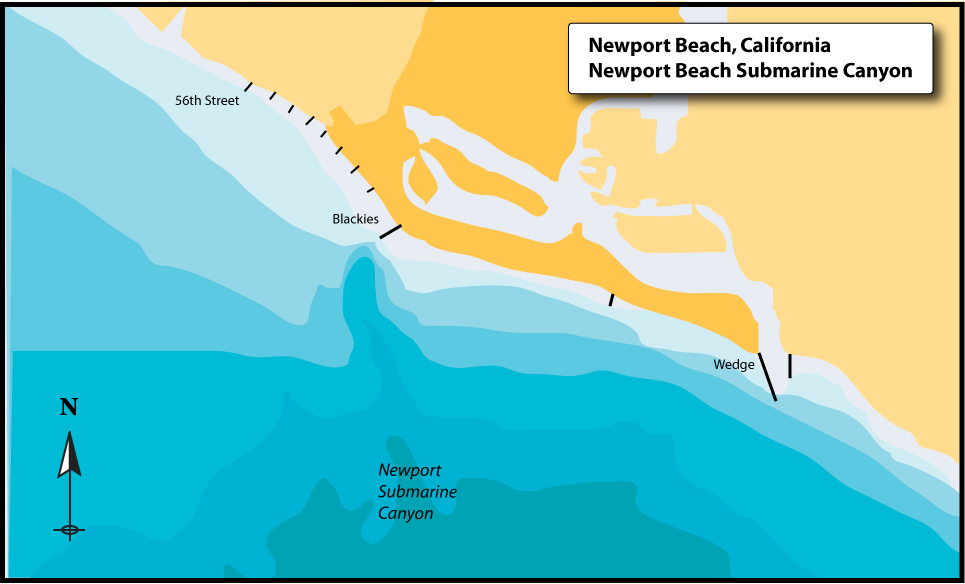
The close proximity doesn’t affect most of the regular inshore species but can produce large numbers of some of the pelagic species that prefer a little deeper water. And, at times, especially at night, a few deep-water fish may make the journey up from the depths of the canyon into the waters of the pier.
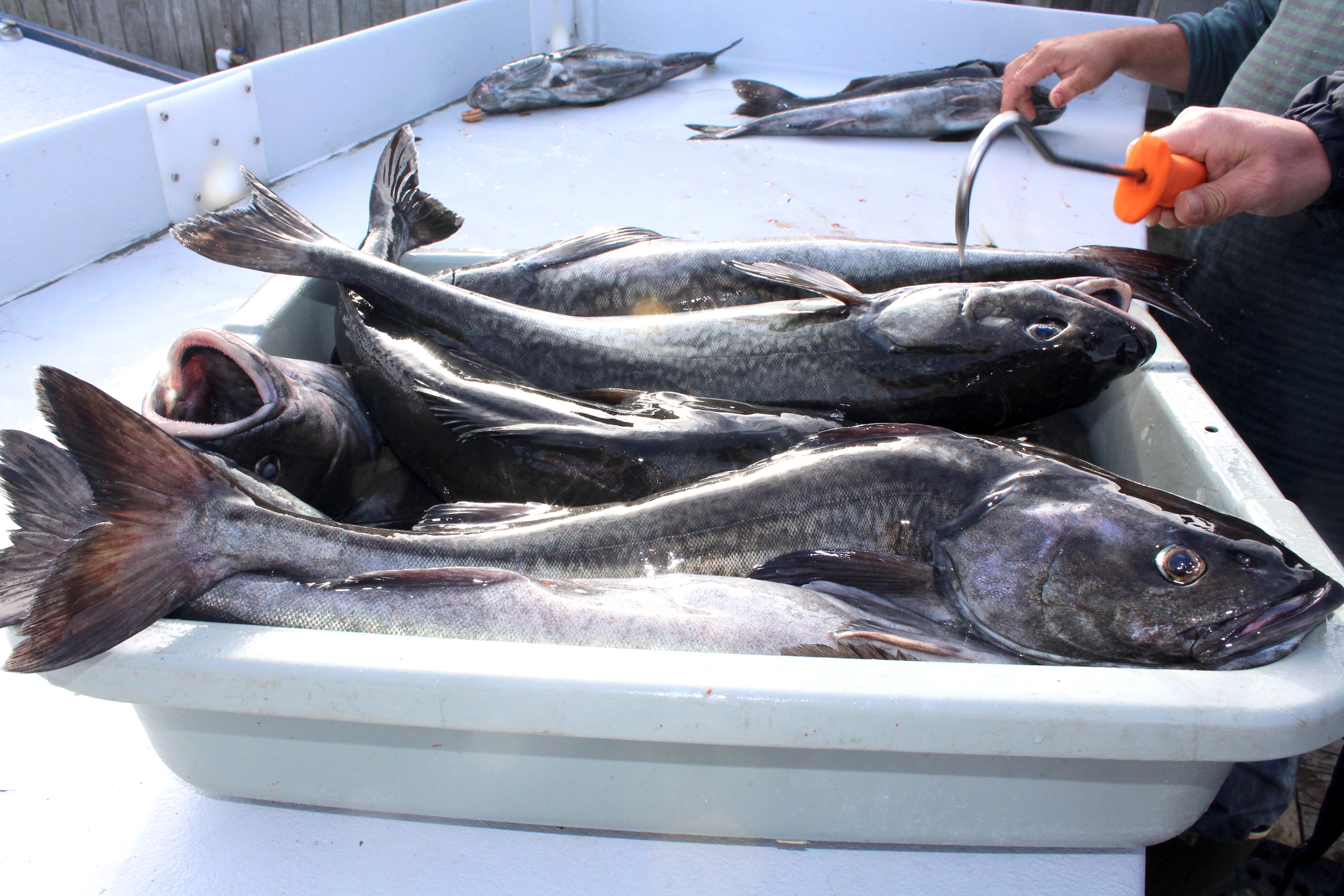
Deepwater Sablefish caught by the dory fleet
As for the normal fish attracting features that are found at most piers, it’s fairly typical. Inshore is found a sandy shore and sandy shore species. Mid-pier sees a mix of the shallow water and deeper water species. The end sees the deeper water species.
The pilings themselves generally have little kelp but are heavily encrusted with barnacles and mussel. The oxygenated water around the pilings attracts some fish, the pilings themselves provide protection for some species, and the various creatures found on the pilings provide food for a number of species.
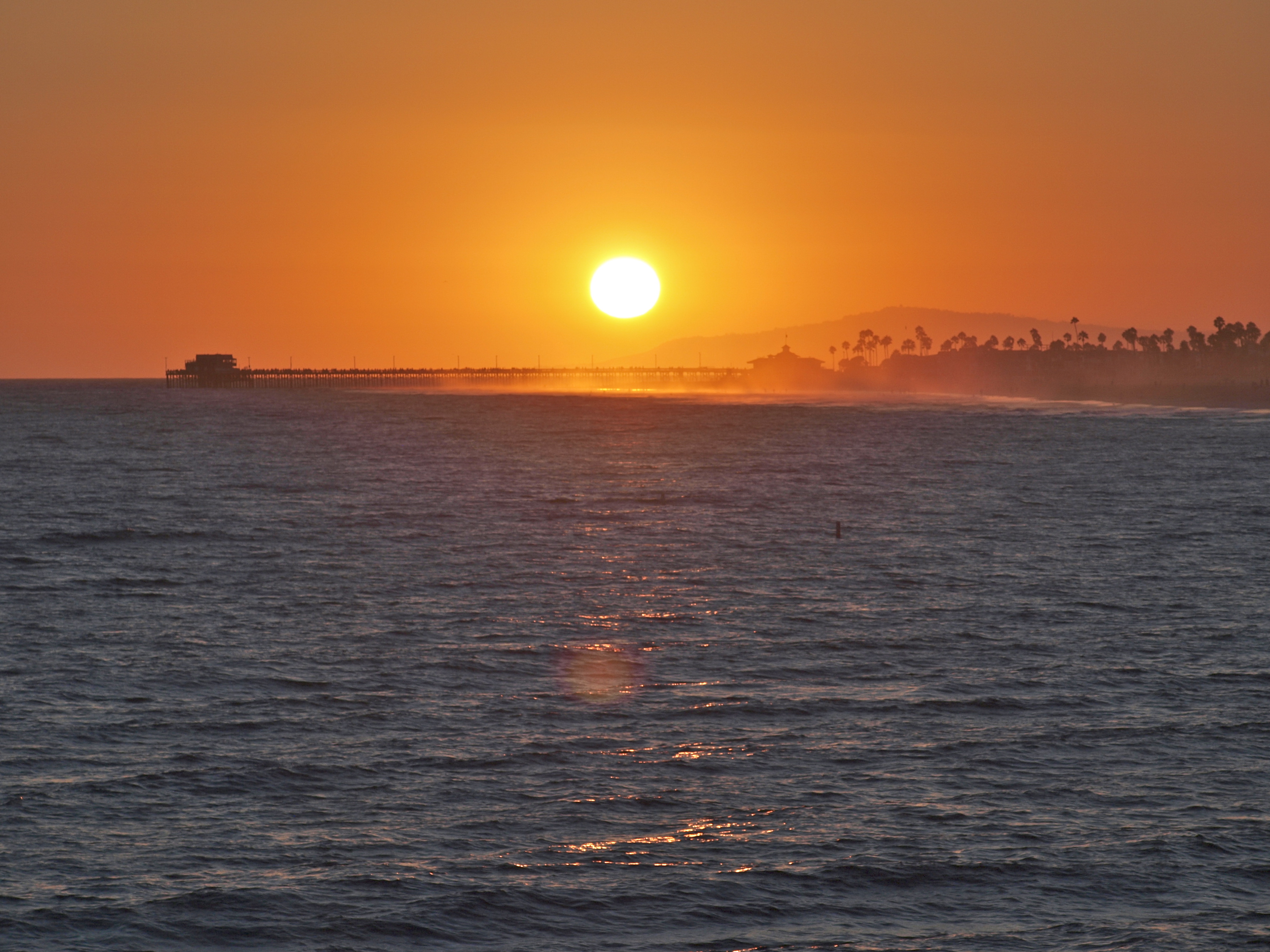
Looking west toward a setting sun over Huntington Beach
The Fish. The California Department of Fish and Game did fish surveys at the pier from 2004-2009 and one fact stood out above all others —the predominance of Pacific mackerel. It was the number one caught fish every year and no other species were even close. Most years see some good numbers of jacksmelt and topsmelt, some years see good counts of Pacific sardines, and warm-water years can see good counts of bonito, but all are far behind the counts for mackerel.
The fact that it is near deep water probably explains the affinity of mackerel for the pier. It’s much the same as at Redondo Beach with its pier and deep-water submarine canyon; the two piers earn the twin sister (or brother) award for mackerel. When the mackerel are running, and that’s often, the end of the pier will be jammed late into the night with mackerel fisherman filling buckets with the mackerel. Blood will be splashed on the deck, railings will be covered with blood, guts and slime (so much for blood, sweat and tears), the water will be filled with glow lights peppering the surface, and whole families will be filling just about every square inch of space at the end section. Of course the number of people, and the mess, helps explain why the pier frequently receives criticism from visitors unused to the blood and guts.
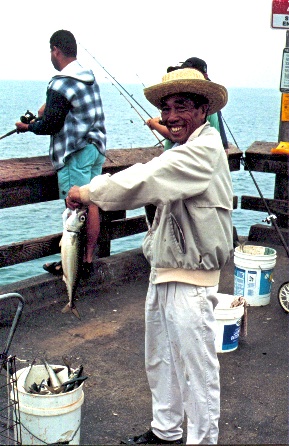
The fact that Newport is a noted mackerel pier isn’t new as seen in this hundred-year-old report:
Fishermen Catching Full Bags Along Coast
Along the South Coast a fine season for the pole fishermen is in prospect. Huge schools of mackerel, kingfish (also called herring), smelt and pompano have already delighted these knights of the rod who fish from piers, while the succulent surf [corbina] has appeared at the usual favorite haunts in satisfactory numbers. The small fish, it is freely predicted, will give great pleasure to those who dangle their line from pier or strand this summer… For mackerel, kingfish, smelt or the like, Newport seems to be the favorite spot. If one avoids the snags on the south side of the pier at the end, one can catch a great variety of small fish from the last named pier. Following is a general summary of fishing at South Coast points: Newport pier: rock bass, kingfish or herring, mackerel, smelt and sculpin generally plentiful; an occasional yellowtail and halibut, and perch may be caught near the piles. Live bait generally procurable on this pier…
—Los Angeles Times, May 30, 1915
As for myself, I have kept records of every fishing trip, and every fish caught, since 1962. My personal records for Newport show a 6.39 fish per hour average and 11.4 points per hour average (a adjusted figure that tries to account for quantity vs. quality). Both figures would place Newport at a mid-point range in comparison to other Orange County piers. In regard to fish per hour, Newport trails the piers at Huntington Beach, San Clemente and Seal Beach (with Balboa and the small pier in Dana Harbor ranking lower). As far as points per hour, Newport is third following San Clemente and Huntington Beach. All the other piers are lower. The bottom line: somewhat fewer fish per hour but slightly larger-sized fish than some of the other piers.
To a degree the figures reflects a pier where the availability of pelagic species—mackerel, bonito, jacksmelt and sardines, have a large affect on the number of fish caught and quality. It’s something seen at piers similarly located near deep-water, submarine canyons—Redondo Beach, Port Hueneme, Monterey Wharf #2 and nearby Balboa. All have a tendency to have a hot or cold nature dependent upon the pelagic species.
However, the pier’s story is much more than just the mackerel, or the unusual species that sometimes travel up from the depths of the deep-water canyon. The pier also sits just down the shoreline from the entrance to Newport Bay so inshore, bay dwelling forms will also be seen. Nevertheless, by and large, the species reflect the normal mix of SoCal pelagic species and more resident species like the perch, croakers, flatfish and sharays.
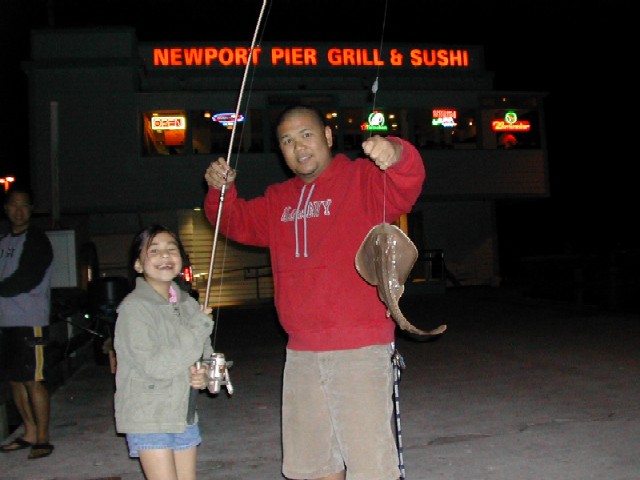
Her first thornback ray
Inshore. Inshore, from the surf area to about a quarter way out on the pier, one can expect to find some barred surfperch, yellowfin croaker, spotfin croaker, and a few corbina. Nighttime hours might also see a few black croaker. Sharays are represented by round stingrays, thornback rays, gray smoothhound sharks, leopard sharks and shovelnose sharks (guitarfish).
A sometimes summertime visitor is mullet that will mull around the pier pilings teasing the anglers up above who are shocked by both their number and size (and often mistaking them for small yellowtail). Eventually the snaggers will get to work snagging the mullies that can be anywhere from the surf area out to mid-pier.
Midpier. Just past the surf zone to midway out on the pier is the best area for the prized halibut while the mid-pier area itself seems the best for walleye and silver surfperch, pileperch, jacksmelt, topsmelt, Pacific butterfish, queenfish (herring), and white croaker (tomcod). A lot of sharks and rays are also taken in this shallower water area, especially thornback rays, bat rays and shovelnose guitarfish.
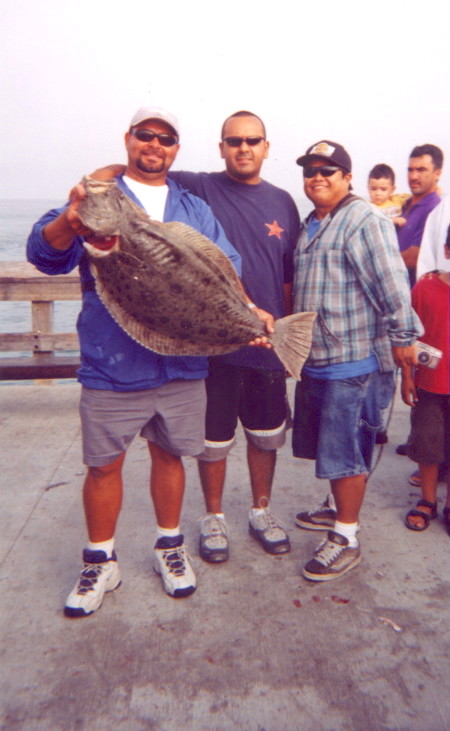
Halibut caught by Humberto
End of pier. The far end is normally best for most of the top-feeding pelagic species—Pacific mackerel, jack mackerel (Spanish mackerel), Pacific sardines, and, some years, bonito (boneheads), and barracuda.
The end is also typically the best for a number of bottom dwellers—sculpin (scorpionfish), sanddabs (both longfin and Pacific), small rockfish, kelp bass and sand bass.
Ditto some large sharks and bat rays (generally at night).
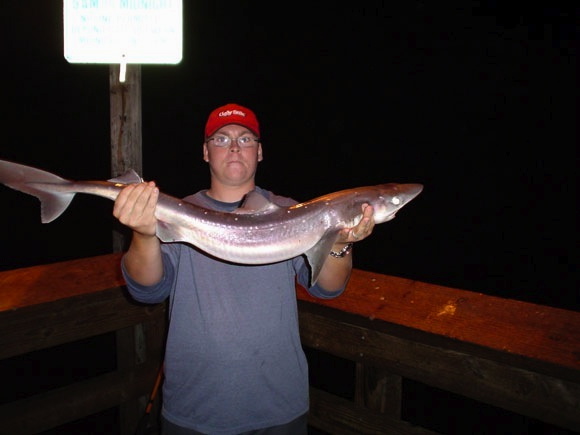
Spiny dogfish are sometimes caught
Since the end has the deepest water, and is closest to the submarine canyon, it is also the spot where most of the deep-water species are seen. The far right corner is where I caught most of my hake and sablefish but today, with the pier closed midnight to 5 A.M., the number of deep-water fish (that sometimes travel up in the water zones at night) seems to have been reduced.
Piling area. Most pilings are heavily encrusted with mussels and barnacles and climbing all over the mussels are a plethora of small species such as crabs and shrimp. Many species stay close to and feed on the creatures of the pilings. Often seen cruising the top water around the pilings, and seemingly almost impossible to hook are large pileperch. Unseen, down near the bottom are blackperch (buttermouth perch), rubberlip perch and an occasional rainbow seaperch; often these will be hanging a foot or so off the bottom. Sculpin, bass, and cabezon also like to hang around the bottoms of the pilings.
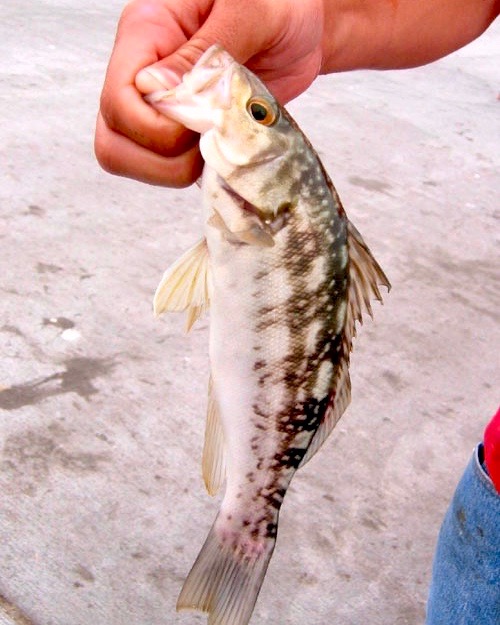
The number of kelp (calico) bass seem to be increasing
Unexpected fish. Unexpected fish, or at least fish uncommon to most southern California piers, are one of the attractions of this pier. The deep-water Newport Submarine Canyon begins (or ends depending upon your point of view) just a few hundred feet southwest of the end of the pier and within 600 feet the water is over 100 feet deep. As a result, fish such as Pacific hake, Pacific sanddab, and longfin sanddab are commonly caught; fish like sablefish are an occasional treat.
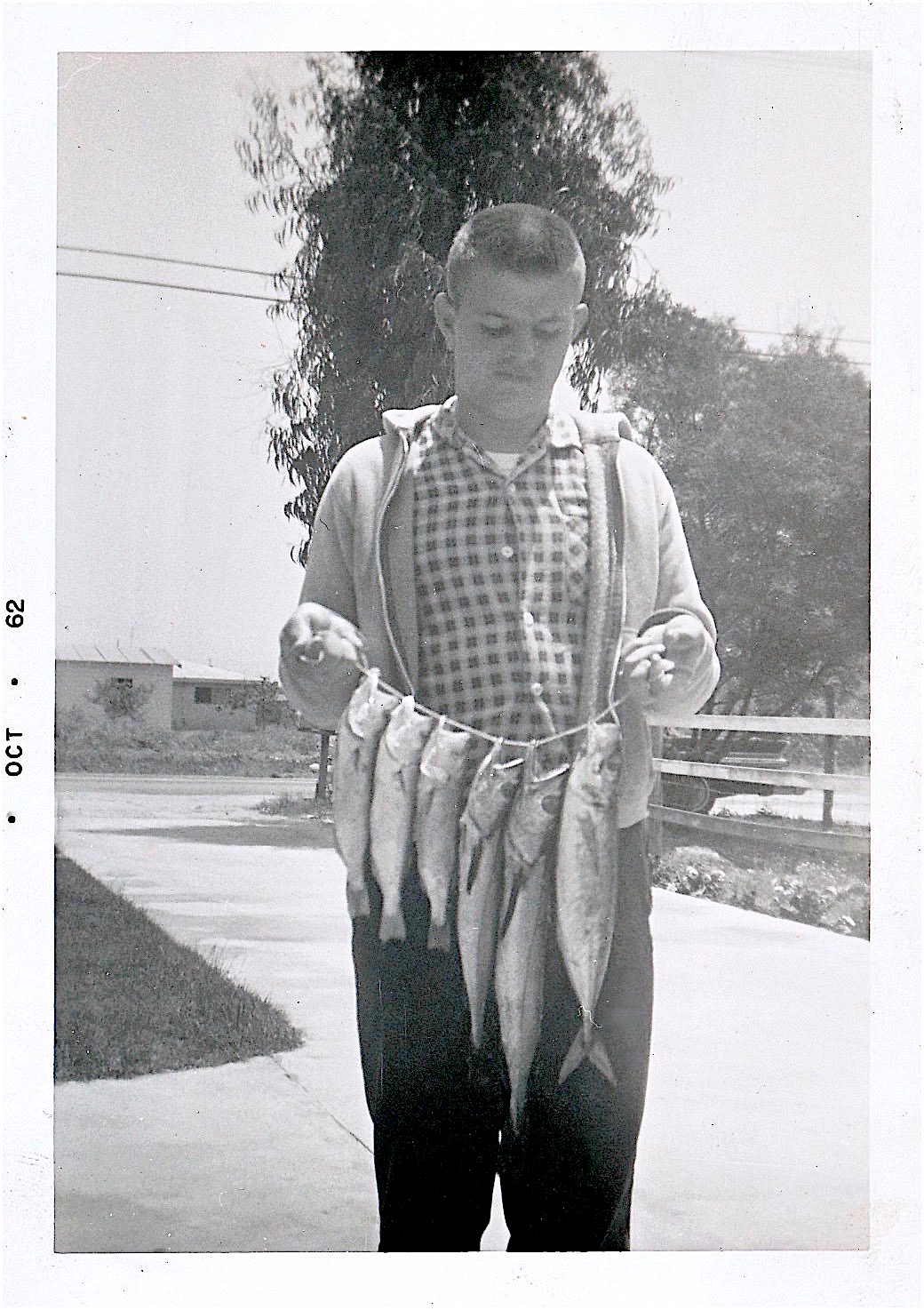
My earliest picture at the pier — three queenfish, a good-sized jack mackerel aka Spanish mackerel, and two Pacific hake.
In April of ’00 a spotted ratfish (Hydrolagus colliei) was reportedly caught at the pier, a fish which is common to inshore areas north of Washington but one which is typically found several hundred feet deep in southern California waters.
In May of ‘01 a triggerfish reported at nearly 10 pounds was added to the list of unusual fish while February of ’05 saw a California skate (Raja inornata) added to the mix after it grabbed a live queenfish.
So many yellow snake eels (Ophichthus zophochir) have been caught in the last decade that it seems to make their “rare” status in the fishery guidebooks out of date. An angler reported catching a “white eel” about three foot long in 2005. No one has a clue as to what eel species the report referred to. Another, more common eel was reported from the end section in 2005—a small foot and a half long moray eel.
In October 1962 I caught a basketweave cusk-eel (Ophidion scrippsae) at the pier, a feat I duplicated in a visit to the pier forty years later in December of 2002.
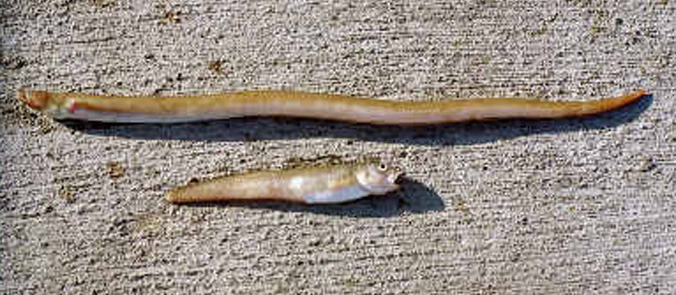
Cusk eel (front) and yellow snake eel (back) — 2002
Given the close proximity to Newpot Bay shallow water species also appear. One of the former is bonefish and two of the fish were reported in 2002. A sarcastic fringehead was reported the same year. Fish and Game catch surveys reported several interesting fish—zebra perch (2004), striped mullet (2004), and a sharpnose perch (2006). In the case of the sharpnose perch, it is the only one I’ve seen reported at a pier south of Monterey Bay.
An impressive catch in the summer of ‘99 was a 180-pound black (giant) sea bass. According to the PFIC post the Brobdingnagian (and today illegal) fish was hooked on a live smelt, battled the angler for two and a half hours before being landed, and then was released. (Only question I have is why a 180-pound fish would hit on a smelt bait? A mackerel or something equally big seems more appropriate.) In the earlier days of the pier such fish were a common catch and anglers targeted the big fish with appropriate heavy tackle. Most anglers hooking such a fish today would simply be spooled and left wonderin’— “what the heck was that?”
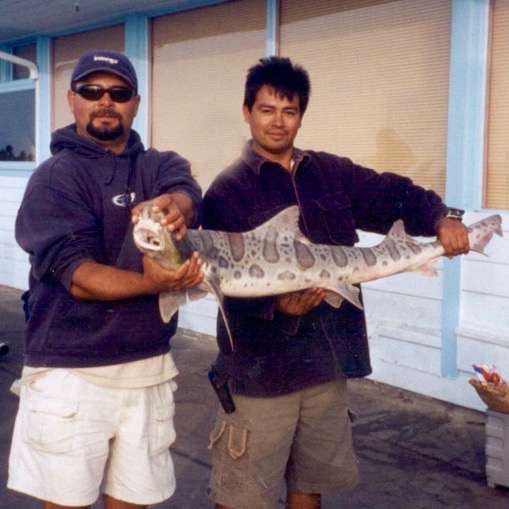
Leopard shark caught by Humberto
I have caught nearly 40 species of fish from this pier, everything from the shallow-water cusk-eels to the aforementioned deep-water sablefish and hake. I’ve even caught a fish that most guidebooks say doesn’t exist in the area—a starry flounder. I caught the flounder on July 4, 1962, and it was the only fish I caught that day with the exception of a sculpin (California scorpionfish). Since no one seemed to know what the fish was, I saved it and consulted the various fishing books I had, as well as the reference books at my high school (Newport Harbor High School). All carried the descriptions and drawings that matched my fish but most said that the southern limit for the flounder was Santa Barbara. One lone book showed a “southern” starry flounder whose range was listed as south of Newport. To this day I believe that book was right and that I caught a starry flounder, or perhaps “southern” starry flounder.
Crustaceans. The pier has never been considered a good pier for bugs, aka spiny lobsters, but it does produce excellent numbers of a related crustacean—large, gnarly-looking spider crabs (sheep crabs).
Cephalopods. Some years will also see visits to the pier by the cephalopod family, generally the smaller market squid (Loligo opalescens),but occasionally their larger deep-sea relatives, Humboldt squid (Dosidicus gigas). While visiting the pier one night in 1976, I saw a tremendous run of Humboldt squid taking place. The giant multi-tentacled creatures exceeded ten pounds in most cases and put up a surprisingly good fight. Unfortunately, I didn’t have a squid jig, no one would sell me a jig, and the jigs were basically the only thing working on the squid. I still tried to catch one of the exotic animals by using conventional riggings, but my efforts produced 0 squid, not a one, nada, zilch.
However, for those anglers lucky enough to have the jigs it was an exciting, squidapalooza kind of night as they hauled in squirting ink sack after ink sack until their arms grew weary. The next morning fishermen were selling excess squid and trading for more desirable species of fish, while squid and ink from the squid seemed to carpet the pier.
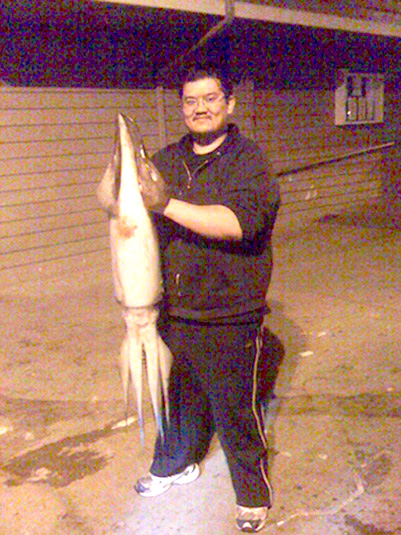
Humboldt Squid — 2010
Similar runs of Humboldt squid took place during the summers of 2002 and 2005, the spring of 2007, and the winter of 2010 (though more limited) resulting in (once again) frenzied crowds, sorrow for those without the coveted squid jigs, and more ink-covered railings and anglers. As mentioned, many runs of the smaller market squid have also taken place (including one in January 2007) although they rarely get much publicity. When you fish on the deep-water end of this pier you just never know what might latch on to your line.
Unlicensed Commercial Fishermen, Poachers & Snaggers. An unfortunate aspect of this pier’s environment, and one that has caused many anglers to give up on the pier is the large number of “commercial” fishermen” on the pier. By this I mean the anglers who are out at the pier with 4-5 rods and whose goal it is to catch, keep and eventually sell as many fish as possible. Whether it is mackerel or other species, they will often fill bucket after bucket with fish. Do they have commercial licenses? No, but the fish are destined to be sold. Some locals suggest the “commercials” outnumber the recreational anglers by three to one (especially when the mackerel, bonito or giant squid are running) and that it is a reason why many locals now head over to the Balboa Pier (although it too can have problems with the “commercial” anglers at times). Most locals suggest that it is primarily these “commercial anglers” who have caused the bad reputation for local anglers—especially due to their sometimes-aggressive conduct and failure to keep the pier clean.
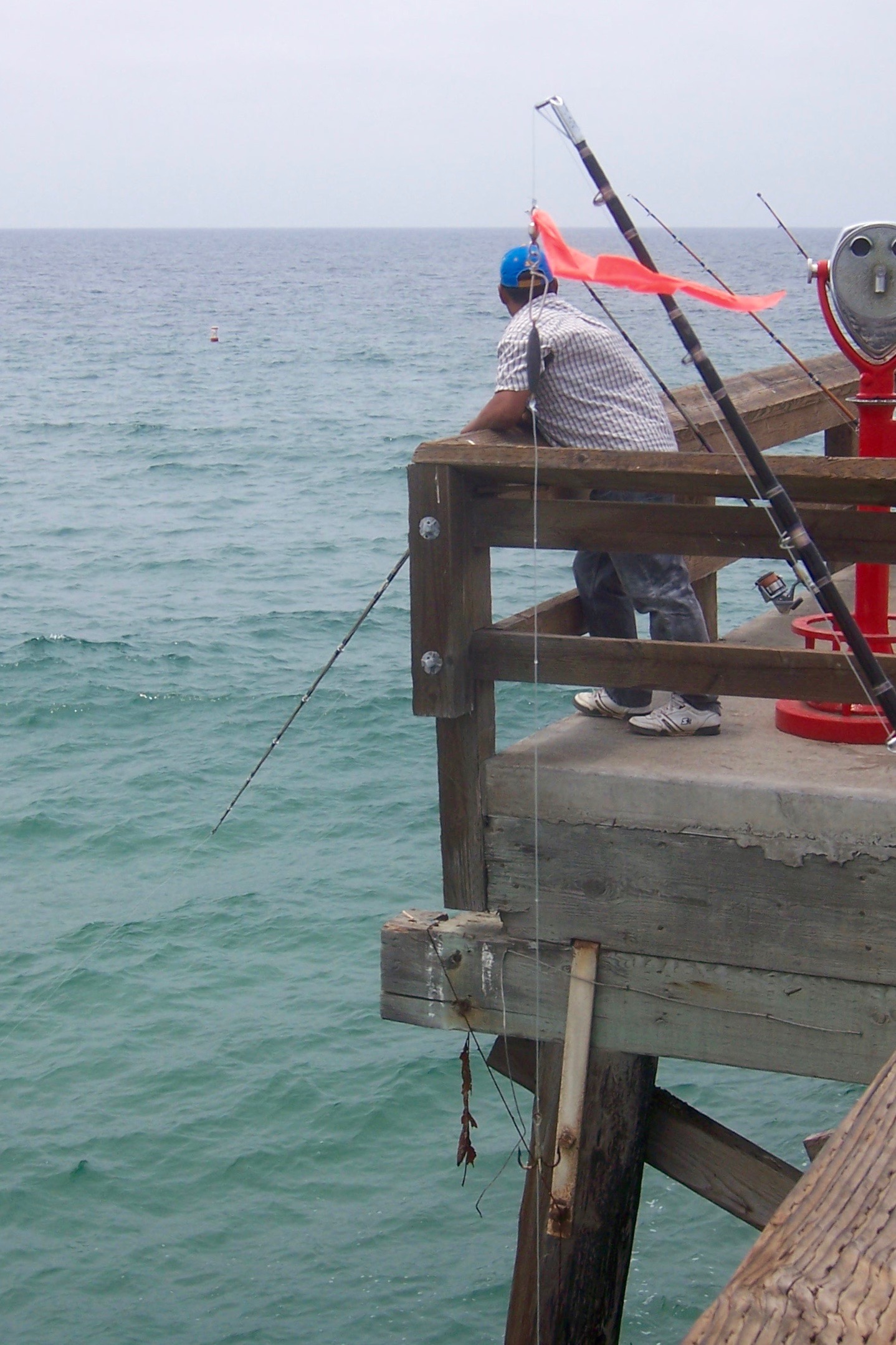
State Fish and Wildlife regulations limit the number of rods that can be used on a public pier to two and many cities have corresponding city regulations. Newport does the same but the rule just doesn’t seem to be enforced. (Of course one PFIC member pointed out that some of the mackerel fishermen put a dozen or more hooks on their line so even a two-pole limit doesn’t totally solve the problem.)
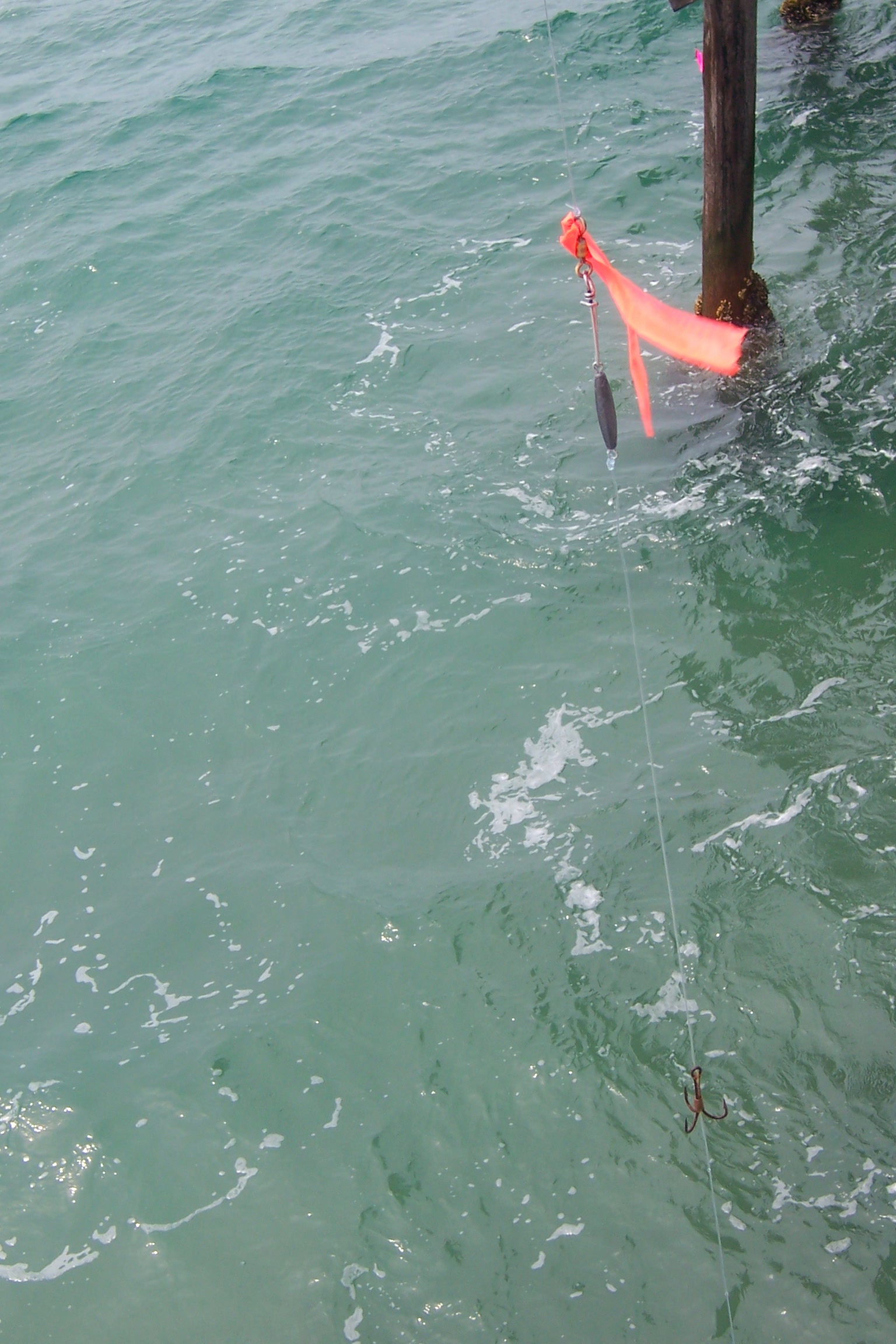
As a result the pier has become one of the hottest poaching areas in the region and it’s all open and viewable by the public (who often walk away in disgust muttering about the number of fish being kept by the slovenly fishermen). Unfortunately “recreational” anglers suffer the consequences when changes are made in response to these actions (as in more restricted hours).
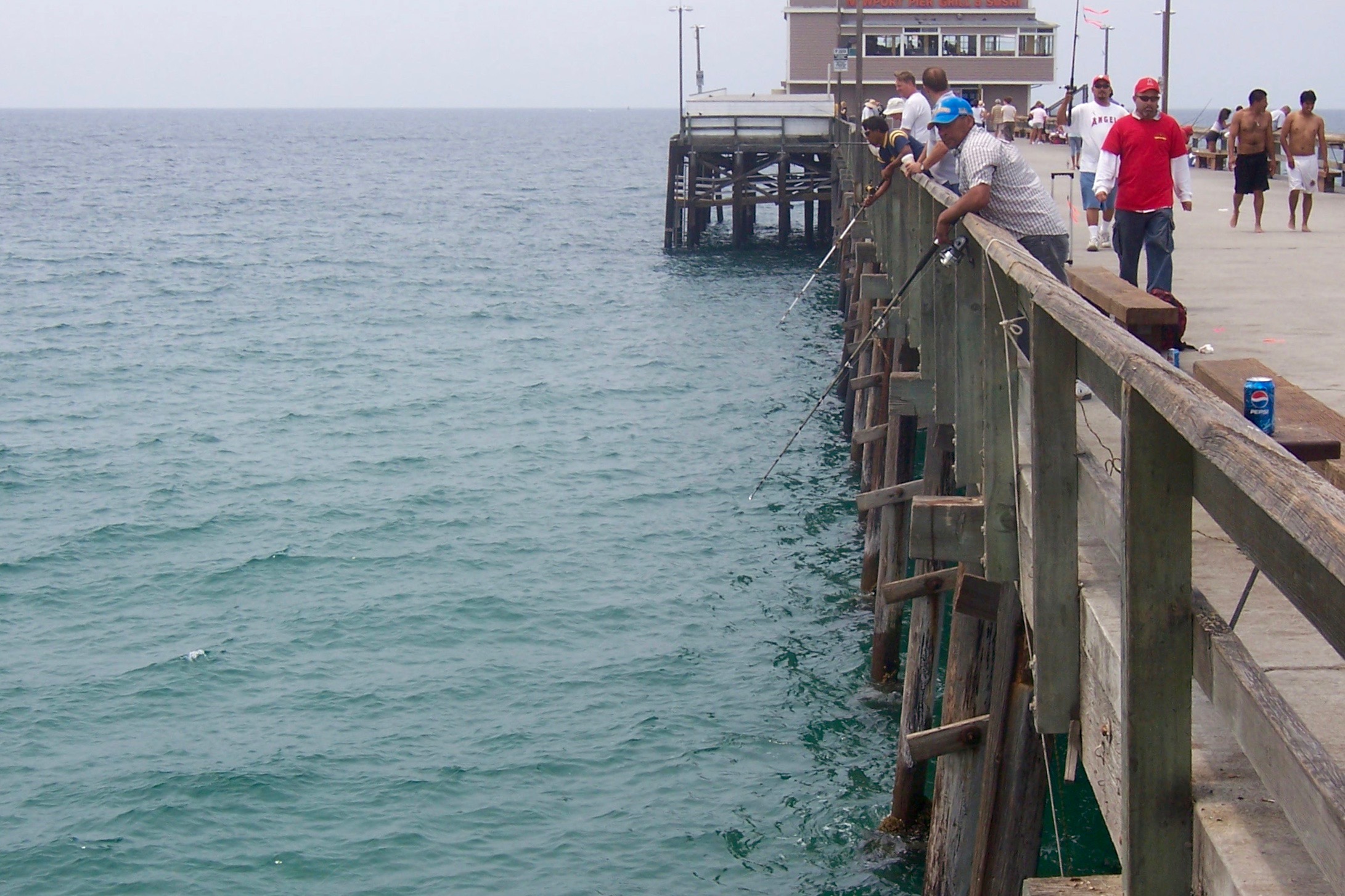
Another detriment to the pier’s environment is the number of scullions aka snag-heads who snag corbina, mullet and other fish in the surf area. Equipment is simple: heavy rods and reels and long leaders loaded with really large treble hooks. Add a couple of pieces of cloth to attract the corbina and you’re in business. Once done primarily in the evening for corbina, today it’s common to see the entire inshore railing lined with these “sportsman” much of the day.
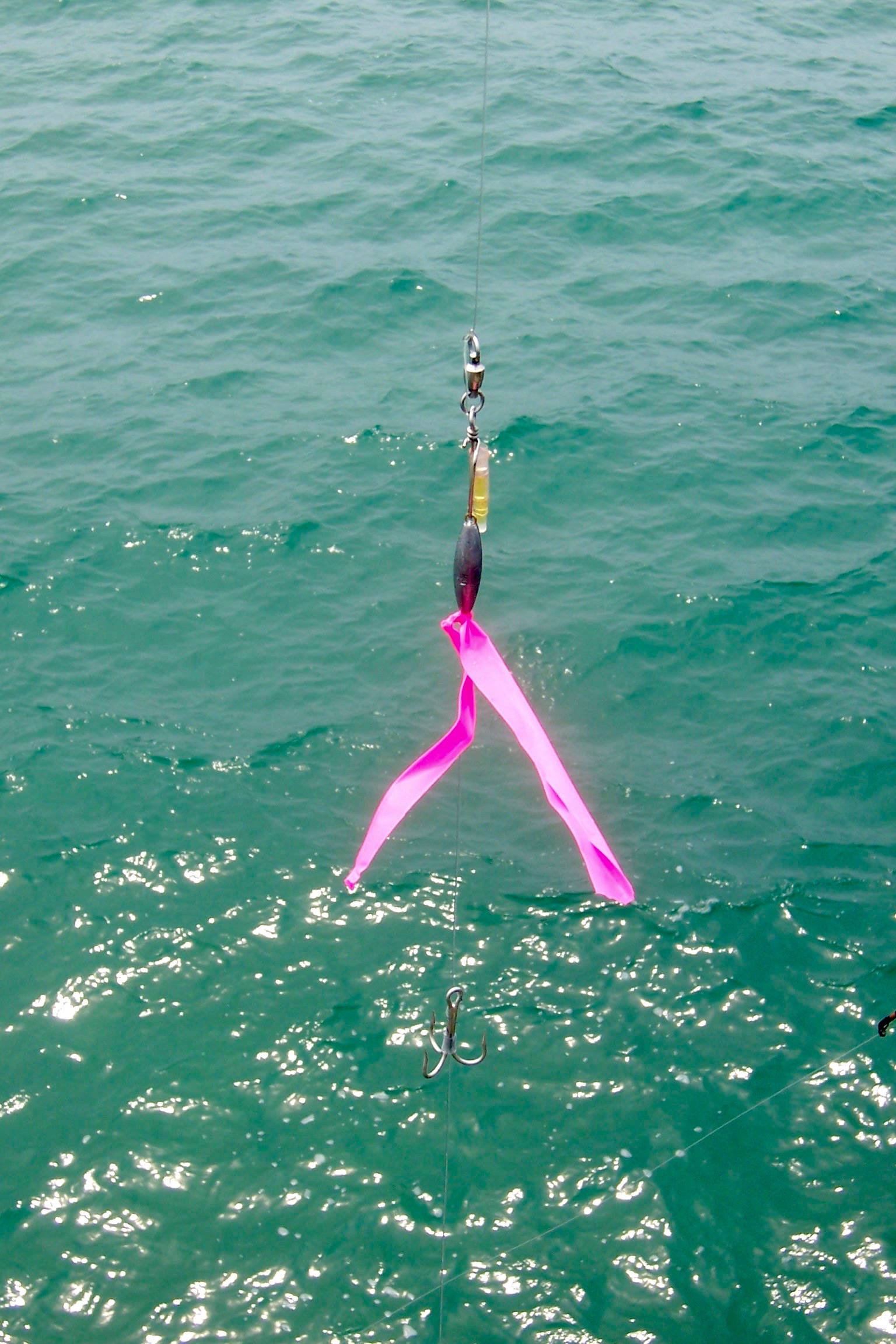
Although some argue that it is legal and merely another form of angling, I feel that snagging corbina (or any sport fish for that matter) should be made illegal by the California Fish & Wildlife Department. As practiced, if a white seabass, halibut, spotfin croaker, or other sport fish is mistakenly snagged, the fish are just out of luck (and it happens daily). Given the legality of snagging fish, there would seem to be little motivation for a warden to visit the pier (at least in regard to the snagging issue). However, regular enforcement of the existing rules would help because under-sized sport fish are regularly snagged, and kept, and that IS an illegal practice. Twice the issue has been brought to the state Fish and Wildlife and twice they have looked the other way (due in part to the common use of bait rigs aka snag rigs that are used for smaller species such as smelt, sardines, and mackerel. However, for many anglers the issue is not one of legality, the issue is one of morality, what is right and what is wrong when it comes to fishing.
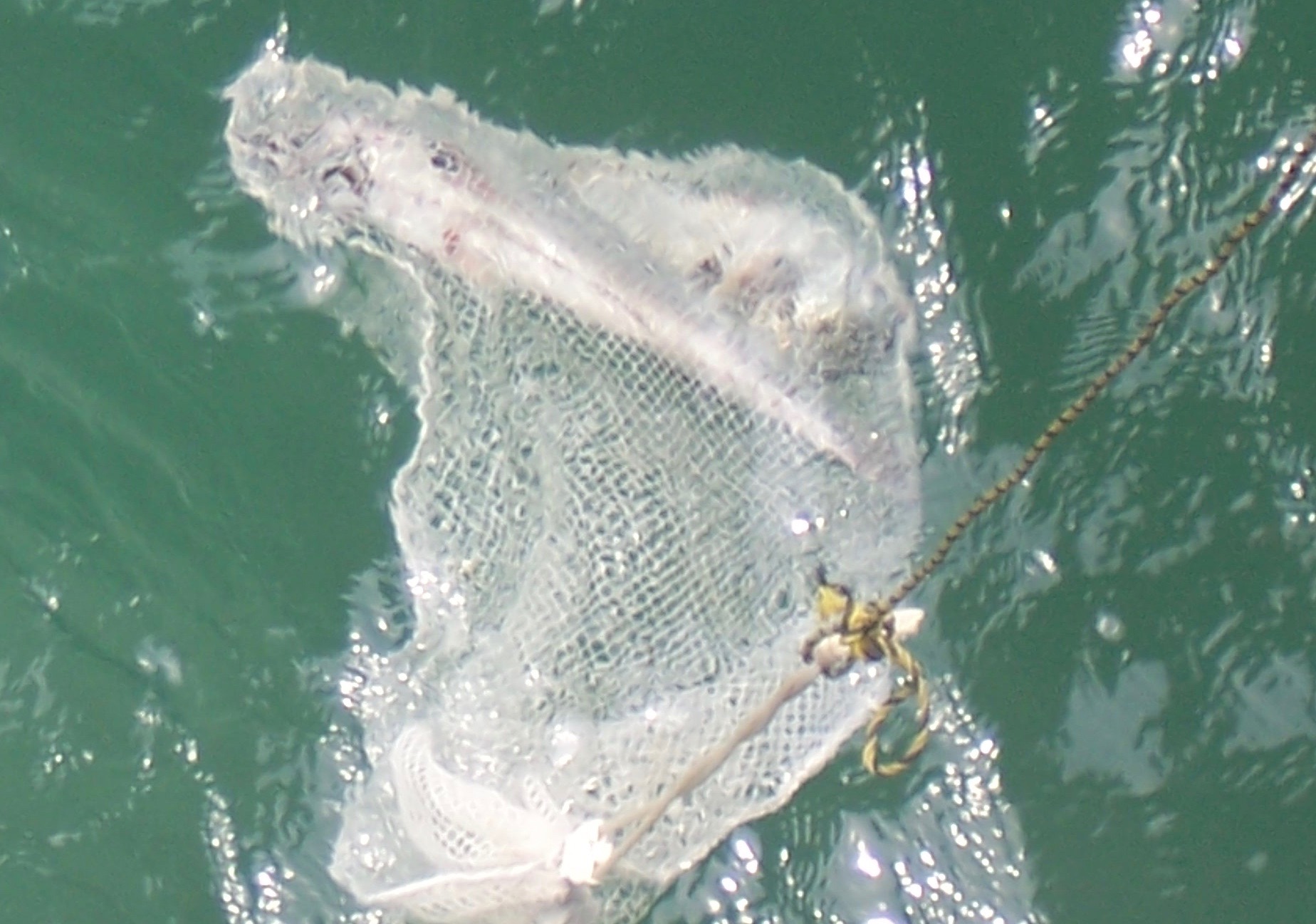
Fishing Tips. Live bait (anchovies, sardines or small smelt), which you will have to net or snag yourself, is the most desired fare for many of the fish. In deeper water, use live bait near the surface for bonito and mackerel; in shallower water, fish on the bottom for halibut using anchovies, sardines, shinerperch, smelt or “brown bait” (queenfish and tomcod). The catch of lizardfish has also increased in the past decade and the slimy, twisty little fish also make good halibut bait.
The left side of the pier, midway out toward the end, used to be called “Halibut Corner” by the regulars. The right corner, where I liked to fish, was the spot for the bonito. Today, the number of halibut (especially legal size fish) and bonito are much reduced (although a 38-pound halibut was reported in May of 2001). However, my visits still seem to show more halibut on the left and more bonito and mackerel on the right. Near shore, use live anchovies orsmelt for guitarfish, sharks and an occasional halibut.
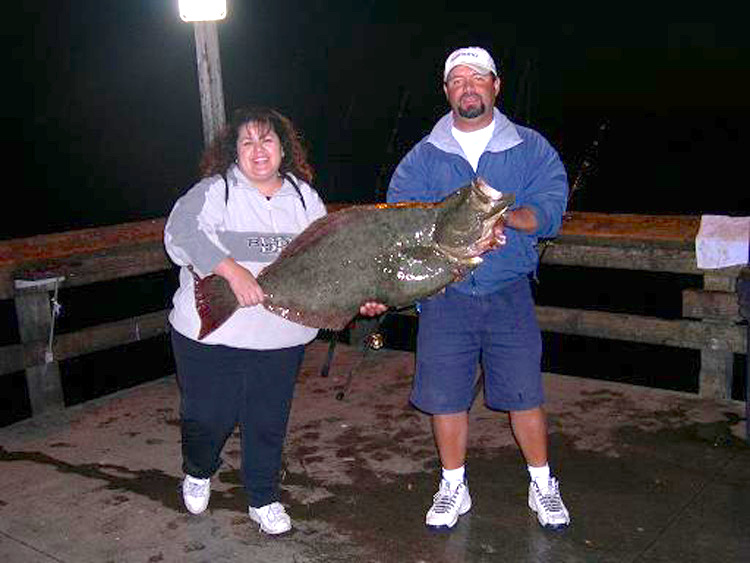
Halibut caught by Humberto
Around the far end, a high-low outfit equipped with short leaders and number 6-4 hooks can be effective. Bait the hooks with small strips of anchovy (no more than an inch long), cast out and retrieve slowly. Often a hungry sanddab, scorpionfish, small rockfish or bass (both kelp bass and barred sand bass) will attack your bait. As said, an increasing number of lizardfish are caught from the end to the mid-pier area.
Unlike many SoCal piers, Newport has never really been considered a good pier for white croaker (tomcod). Having said that, I must admit that I have some days where the tommies wouldn’t stay off the line; cases where an angler could literally catch a fish or two every cast until the arms got tired. What is strange is that all of these occurrences took place between late February and early April. This is a little unusual because the standard wisdom on white croaker is that they travel out to deeper water during the winter months and come inshore during the late spring to fall months. Nevertheless, I have never caught more than five during a summer or fall visit. If the tommie croakers are around when you visit, the same rigging and bait mentioned above (high/low leader and strips of anchovy for bait) should guarantee success and generally the fish will be found mid-pier to the end. However, begin the retrieve just as the sinker hits bottom and be prepared to strike even as the bait sinks. A shiny sinker will also increase your chances of success.
A bait-rig-type outfit, made with number 8 hooks and baited with small pieces of anchovy, will tempt walleye surfperch when fished mid-depth. Silver surfperch will generally be above the walleye, and jacksmelt and topsmelt will be above the silver surfperch. However, the jacksmelt will bite better on small pieces of bloodworm or lugworms. Although I had never caught a single sardine when fishing the pier in the’60s, they returned and I’ve caught them regularly since the ‘90s; the usual ways to get the ‘dines is with a Sabiki-type bait rig. These rigs may also attract a few pompano (California butterfish) or salema. Of course, the best use of these bait rigs is to catch some live anchovies, small smelt, baby macks, small Spanish mackerel (jack mackerel) or shinerperch. All make good live bait for halibut and at least decent bait for bass, sharks and rays.
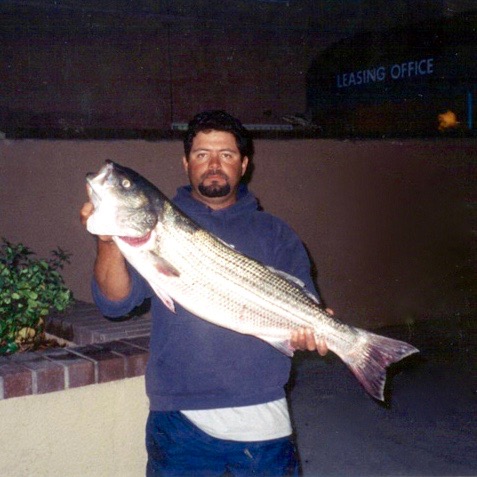
A striped bass caught by Humberto
Small jack mackerel are also by the way, a favorite bait for yellowtail. Although common to the pier a hundred years ago, those days are over. Nevertheless, yellowtail are usually reported each year, typically in the late summer to fall months (and, during El Niñowarm-water years anglers may see them much of the year). Although most of the yellows will be small firecracker-size fish, some larger fish may also show up. During 2015, an El Niñoyear, several yellowtail in the 30-40 pound range were reported hooked—and lost during September.
To catch the large pileperch, which are often seen grazing on the mussels on the pilings, requires both skill and perseverance. Use fresh mussels, small hooks, and light line, and be able to hold your bait near the pilings without getting it snagged. If you’ve hid the hook well you might catch a fish! Old-timers would take a clump of mussels (still in their shells), wrap several short leaders around the mussels (while trying to hide the various hooks), and then drop the entire mass of mussels down by the pilings. If everything worked to perfection a pileperch might be foolish enough to grab one of the hooks entangled in the mass of mussels. Another trick was to put a hook through a small, unopened, thumbnail-size mussel or a small sidewinder crabs (if you could find them). Both produce big perch.
Although sand crabs, especially soft shelled sand crabs, seem the top bait for surfperch and corbina, fresh mussels, ghost shrimp, bloodworms, and lugworms will all produce the normal inshore species—barred surfperch, spotfin croaker, yellowfin croaker, corbina, and an occasional sargo or black croaker. For the corbina you need to practically be fishing in the sand, the others will be found from the shallows to the mid-pier area. Of course many of the regulars today use nothing but artificial lures for the barred surfperch—root beer or motor oil-colored grubs and Berkeley Gulp being the most popular.
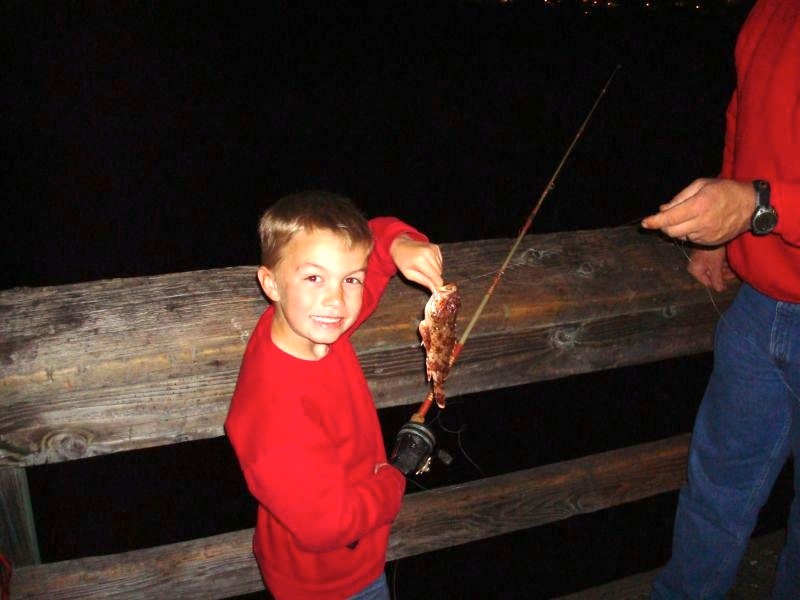
Scorpionfish are very common at night in the winter months but most are a little bigger
I’ve long felt that Newport and Balboa just might be the best piers in the state for California scorpionfish (called sculpin by the locals). Nighttime during the winter months is the prime time for the scorpies and squid strips are the best bait (a small strip squid no more than a half-inch by an inch cut in a V-shape). The end area is the best spot and some say the left side of the end is the “primo” spot (although I’ve caught them mid-pier to the end). Do check the regulations on sculpin since their capture is now restricted part of the year and make sure you return the little ones that outnumber the keepers at least five to one. The small strips of squid may also pull in a mislaid rockfish if they’re around and I’ve caught bocaccio, olive rockfish, and calico rockfish at the pier. By the way, even though the scorpionfish are called sculpins, they and their rockfish cousins are all members of the Family Scorpaenidae, they are not members of Family Cottidae, the true sculpin family. Such confusion among families is enough to make a genealogist weep.
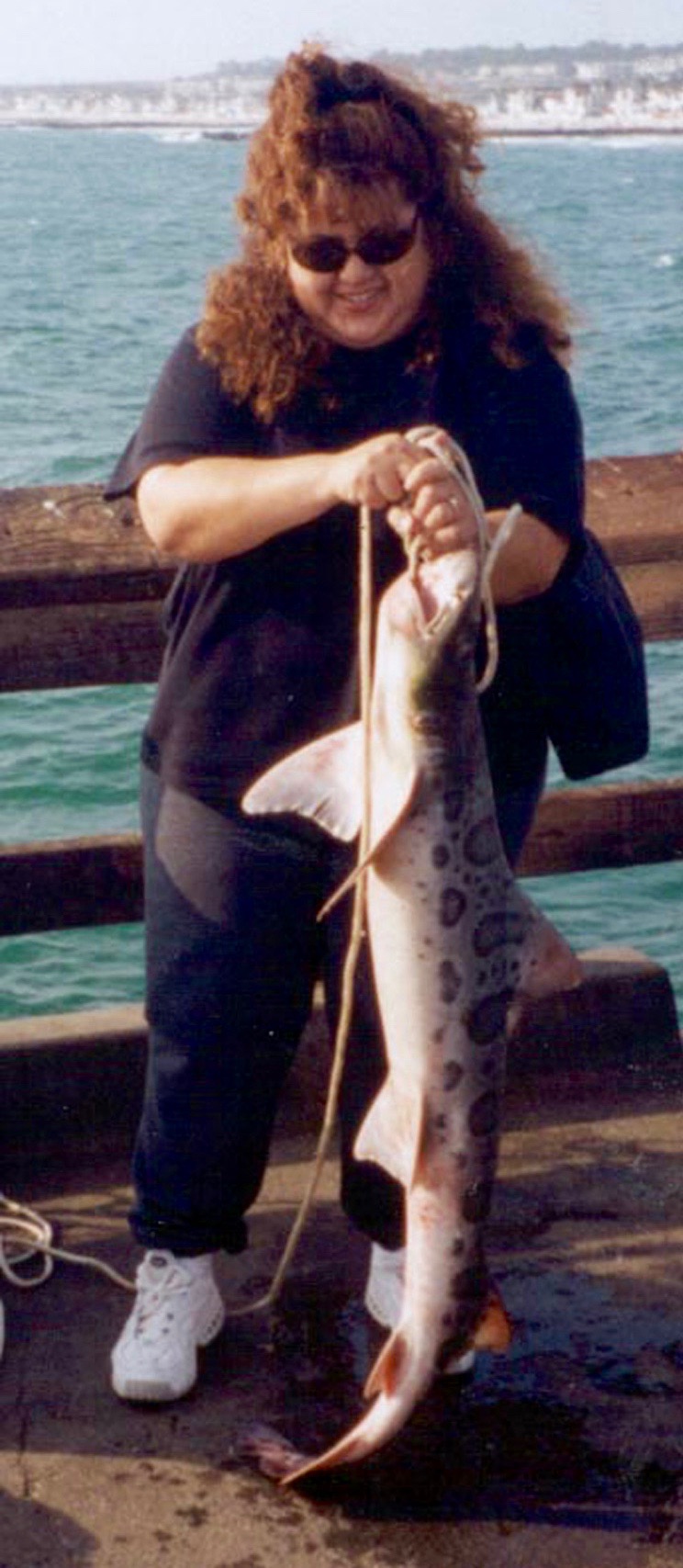
Leopard shark caught by Maria
At night, this can be a good pier to catch both sharks and rays. Although most of these will be of modest size, some are true showstoppers. Included in the list have been a number of fairly large thresher sharks, a 225-pound hammerhead shark, a 246-pound bat ray (see below) and a 176-pound bat ray. A 15-year-old angler took the eight-foot-long hammerhead in 1978. For these bruisers, a heavy rig is required as is a way to get them onto the pier. Come prepared with sufficient equipment (and friends) if you plan to tackle these fish at night. The only surprise to me is the lack of reports concerning either a seven-gill or six-gill shark. Both of these big deep-water sharks would seem to be naturals for the pier but I haven’t seen a report on either species. Smaller horn sharks and swell sharks have been reported but both are uncommon visitors to the pier.
The pier is noted for large shovelnose sharks (guitarfish) and bat rays. Shovelnose approaching five feet in length seem to be caught every year as do bat rays topping the century mark in weight. Although my records show that most of the large shovelnose traditionally have been landed in the mid-pier area, a lot of the big fish have been landed out by the northwest corner in recent years. I don’t know the reason for the change; I only report it. The bat rays on the other hand seem to mostly congregate mid-pier although they are caught inshore to the end area. The shovelnose will hit everything from live ghost shrimp and live small baits (smelt, queenfish, white croaker) to cut mackerel, anchovies and squid. It’s somewhat the same with the bat rays although squid seems to be most preferred.
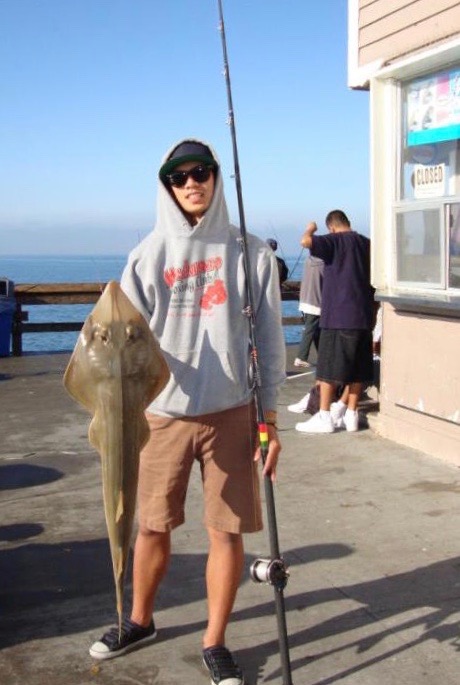
A small shovel nose shark (guitarfish)
Remember when you’re seeking out the shovels that they may weigh upwards of thirty pound so have appropriate gear. The same is true with the bat rays (mud marlin) but they can be even bigger and stronger. Also remember to have a way to bring them up onto the pier. Although I used to recommend using a treble-hook-gaff, today I always recommend using a net for the large fish. Only rarely will a fish be too big for a net. If you do use a gaff, be sure you intend to keep and use the fish. In most instances a gaffed fish will not survive and in the case of the big bat rays, they’re all females and often they’re carrying young.
Catching shovelnose sharks at Newport has been a long time phenomenon as reflected in the following quote.
“Rhinobatus productus Ayres. Shovel-nose Shark, Guitar Fish. At Newport Beach a favorite sport of the “Sunday fishermen” is catching these large rays from the pier, where numbers take the bait and are hauled up every day… Stomachs of adults of this species all contained small crustacea (crabs, shrimps, etc.), and a number of polychaete worms. No other food was found.”
—First Annual Report, Laguna Marine Laboratory, Pomona College, May 1912
This is also a pier that sees a lot of the maligned throw-‘em-back rays (thornback rays). Why maligned? They’re small, they’re overmatched on most gear, they don’t have enough meat on them to furnish much of a meal, and they take the bait that’s quietly sitting there waiting for a more desired catch. An alternative view—the small rays are fun to catch on light tackle and should be released gently back down into the water.
Artificial lures can also be used here, especially when the pelagic species such as bonito and mackerel are running. Bonito feathers used with a splasher (a cast-a-bubble or wooden ball), and several types of spoons and plugs, have been proven to work for the boneheads. Most mackerel are caught on multi-hook bait riggings, i.e., Sabiki or Lucky Lura, (although fairly light tackle with a single hook can be more fun).
More and more of the regulars are even using artificial lures for halibut. Most halibut seekers use swim baits such as Big Hammers or Fish Traps although an increasing number use the Lucky Craft lures. Whichever lure, fish on the south side of the mid-pier section, or even closer toward the beach. Early morning hours when it is not too crowded offers the best chance for success and I am told that while the larger jigs work well in the winter and spring, smaller jigs are more successful in the summer and fall months. A favored method is to “troll” the lure between the pilings since the halibut often lie in wait on the bottom between those those pilings and lunge out when a baitfish passes by. Your job is to make them think your lure is that baitfish.
White Sea Bass
White sea bass also visit certain piers at times, and heavy specimens are pulled up. An instance of this occurs at Newport, where during the dark of the moon in late spring these fish make nightly raids on the hopeless sardines quaking under the pier. Word of this situation drifts inland, and thongs of ardent anglers jam the pier from dusk until the wee hours of the morning, all bent on hanging up a few fine tasting lunkers… Sardines are obtained for bait by snatch-hooking them, and when impaled on 2/0 to 5/0 size hooks of O’Shaughnessy brand it seems that 15 to 20 pound bass are commonly duped into grabbing hold. Some even run as high as 50 pounds…and you can imagine the furor one of these babies creates among the pier fishermen!
—Mortimer Norton, Pacific Coastal Fishing, 1950
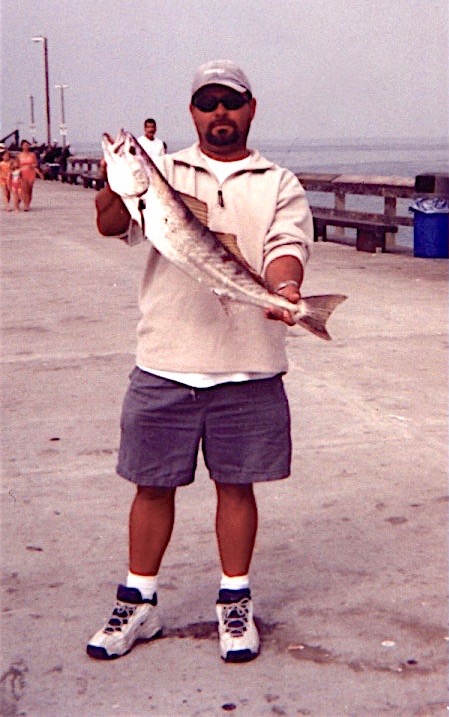
White Seabass caught by Humberto
A final recommendation is to try chumming. Although fewer and fewer people seem to chum for fish, it is still a tried and true method to attract the hungry critters. A couple of variations are most common. The first is to bring along a few pieces of old stale bread. When moistened slightly and rolled into dough balls they will attract smelt and many other small species. What seems to happen is that a few fish get excited which is followed by a frenzy of sorts by the other fish. Food is in the water and, quite naturally, they all seem to want it.
A second technique is to simply cut up some pieces of fish, bait or trimmings. Cut the chum into small pieces and sprinkle a few pieces into the area you are fishing whenever things seem to be slowing down. Better still is to use crushed items such as fish themselves or attractants like smashed mussels or barnacles. If you clean your fish at home, purchase one of the old fashioned manual grinders (or splurge and get an electric model). After cleaning your fish, cut up and then grind down the head, tail, bones, miscellaneous pieces of flesh and the guts. You will wind up with an interesting little mélange. Next, put the pieces in small zip-lock baggies and freeze them. Each time you go fishing take along a few bags to use as chum. Sit them out to thaw and dump some of the chum into the water as needed. Make sure you do not put the bags themselves into the water! Also, don’t over do it, you want the fish to be hungry. But do remember that it’s a good way to attract fish. By the way, oily fish such as mackerel or sardines are the best to use in your mixture, at least for fish that eat other finfish. Their natural oil will coat the surface of the water and can attract fish from quite a distance.
As for mussels and barnacles, the traditional way was to lay a few on the deck of the pier and stomp them with your shoes. Better, both for your shoes and the pier, is to put them into a bag, beat them with a hammer, and then use them as chum. Some people place an old towel under the mussels, crush the mussels, and let the juice soak into the towel. They then cut small pieces of the now smelly and good flavored (for the fish) towel and attach them to their hooks.
Feeding the Fish
Selling fish bait year in and year out, we learned that any time a dredger started dredging in the bay, that was the place to send the anglers…Clam and cockle, crabs and other marine life was ground up and sucked into the dredger pumps with the mud and water for the trip through the dredger pipeline…Fish from all over came to the scene to join in the big feed…
For years I had the daily job of hauling garbage cans of garbage from Newport restaurants out onto the Newport Pier and dumping the garbage overboard. My dad wanted to keep fishing good around the Newport Pier… Fishing was always better from the Newport Pier because of this extra food the fish received, verified by George Hiner, the live bait stand operator. Whenever I dumped the garbage, that’s where the fishing was best, he said. Esthetically, it didn’t look too good—the garbage floating away from the piling but the fish and birds certainly went for it.
—Hugh McMillan, Beach Rat Days,1973
Someone in government would either have a heart attack or be in a state of apoplexy if people today were dumping their trash into the ocean but there is little doubt that the fish loved it and, like chumming, it attracted the fish.
Potpourri — A plethora of hopefully interesting information about the pier
<*}}}}}}}}}>< — As mentioned earlier, fish surveys done by the Department of Fish and Game from 2004 to 2009 showed the dominance of Pacific mackerel in the pier’s overall numbers. Of the 30 species recorded, Pacific mackerel were first with 1361 fish while the second place fish, Pacific sardine, showed only 221 fish and the third place fish, jacksmelt, showed a count of only 143. Thus the easy name of “mackerel pier” for Newport. However, many more species were also caught (numerically) — Pacific mackerel, Pacific sardine, jacksmelt, Pacific bonito (all from one year—2004), topsmelt, white croaker, barred surfperch, northern anchovy, shiner perch, shovelnose guitarfish, jack mackerel, queenfish, yellowfin croaker, California lizardfish, white seaperch, barred sandbass, spotfin croaker, California corbina, silver surfperch, sharpnose seaperch, staghorn sculpin, striped mullet, walleye surfperch, Pacific butterfish, California halibut, Pacific sanddab, fantail sole, sargo, zebra perch and gray smoothound shark. Given the lack of shark and ray numbers it is fairly clear that surveys were not done at night. In addition, the count for sharpnose perch (3) is suspect; they are rarely taken this far south.
Based upon the Dept. Fish and Game surveys, my personal records, and PFIC reports, we’ve recorded 68 different species at the pier which ranks it second in the state as far as piers and fish variety.
<*}}}}}}}}}>< — There was a time when the Newport Pier was considered one of the best places in southern California to catch a white seabass. The following stories reflect the amazing fishing that sometimes occurred from the late ‘20s until about 1950.
61-Pound White Sea Bass Taken Off Beach Pier—Newport Beach, Dec. 1—The largest white sea bass or sea trout ever caught off Newport Beach was landed by Roger Jackson, of Long Beach. The fish was caught off the Newport Beach pier on light tackle and weighed 61 pounds. Old time fishermen at Newport Beach today reported the fish to be the largest of its kind they had ever seen. Fishing from the Newport Beach pier is improving, according to reports. Mackerel and bass are biting well.
—Santa Ana Register, December 1, 1927
Report Good Catches Of Bass At Beach Pier—Fisherman off the pier at Newport Beach had another fruitful session last evening when seven more white sea bass were caught during the unusually high tide between the hours of 4 and 8 o’clock. Most of the big fellows were caught on shiny sinker spinners and No. 9 line. A huge net rigged up on the end of the pier was used in landing the bass. Night before last several large bass, all reported as weighing over 50 pounds were caught. The fish last night weighed between 30 and 40 pounds each. Another seven-foot tide this evening is expected to result in the catching of many more of the large bass.
—Santa Ana Register, June 8, 1933
Two of the most exciting events of the sport fishing season in southern California are the brief runs of white sea-bass at Newport Beach and Avalon, Santa Catalina Island. During the dark of the moon in May, the seabass strike into the pier at Newport on nightly raids on the large sardines hanging around the pier. On those nights, from dusk until about 3 a.m., the pier is literally thronged with fishermen. If there is any angler you want to locate, you will find him at Newport on some balmy May night. Large sardines, caught by snagging, are used as bait. Live ones are best but dead ones are fair. The nightly catch ranges from nothing to perhaps twenty, so most of the fishermen are not successful. Very seldom is a fish less than 20 pounds taken, nearly all running from 40 to 50 pounds.
—Tage Skogsberg, Fish Bulletin No. 54. The Fishes of the Family Scianidae (Croakers) of California, California Division Of Fish And Game, 1939
White sea bass also visit certain piers at times, and heavy specimens are pulled up. An instance of this occurs at Newport, where during the dark of the moon in late spring these fish make nightly raids on the hopeless sardines quaking under the pier. Word of this situation drifts inland, and thongs of ardent anglers jam the pier from dusk until the wee hours of the morning, all bent on hanging up a few fine tasting lunkers… Sardines are obtained for bait by snatch-hooking them, and when impaled on 2/0 to 5/0 size hooks of O’Shaughnessy brand it seems that 15 to 20 pound bass are commonly duped into grabbing hold. Some even run as high as 50 pounds…and you can imagine the furor one of these babies creates among the pier fishermen!
—Mortimer Norton, Pacific Coastal Fishing, 1950
<*}}}}}}}}}>< —I rarely discuss specific tackle shops, but Baldy’s, which used to sit at the foot of Newport Pier, was a special shop for me. In 1962, while still a neophyte to pier fishing, I bought my first “good” reel at the shop, a Penn 700 that I used for many, many years.
Later I moved from the area but whenever I would return I would make sure to stop in whether for bait and tackle or just to see what changes had taken place. Eventually, when I began my annual trips down the coast, it was always a destination spot when I got to Newport Beach.
In my later visits two unique items at the shop always impressed me. The first was a mounted fish hanging on the wall—the largest yellowfin tuna (Thunnus albacares) ever caught (at that time), a gigantic 399.6-pound fish. Even more amazing, on the counter under the glass was a picture of a 34-foot-long, 4-ton basking shark (Cetorhinus maximus) which was landed by the dory fleet and hauled onto the beach back in the early years of the century—a gargantuan prize from an earlier time.
Alas, in 1995 the lease was up, the rent was increased, and the shop was forced to close. Combined with the asinine threats to restrict angling on the pier by the local authorities (spearheaded by a local business group), it reflected the change in Newport Beach, an upscale town which no longer seems to recognize the special status that should be reserved for our lowly pier fishermen.
Baldy’s Forced to Cut Bait After 73 Years
Even now, 79-year-old Tony Scarich remembers that moonlit night in the ’40s when he and his brother caught more than 100 spiny sculpin off Newport Pier and hauled them home by wheelbarrow—so many that the boys at Baldy’s Tackle wondered if they weren’t just hearing another Big Fish Story.
Even now, salty old-timers swear by the wiggle of the store’s mint-green Baldy Jig, a lure so irresistible to fish that fishermen still mourn the loss of the original mold in a fire in the ’60s. Nowadays, small boys with no fish smarts but plenty of moxie still drop by Baldy’s to hoist their big catch by the gill—maybe a 2-pound bonito—and lay claim to the day’s bragging rights.
But Baldy’s, the oldest tackle shop in Orange County, isn’t the hot spot that it once was—these days, a sushi bar packs in crowds at the end of the pier, and locals peruse a boardwalk shop that sells sterling silver toe rings. Baldy’s, a victim of changing times and competition, closes for good on Sunday after 73 years at the foot of a pier that was originally built as a fishing port. “It’s an end of an era,” said John Horst, 84, a man with a sun-freckled face who got his first pole at Baldy’s at age 12 and still fishes off the pier every week. “The town is going modern, I guess, away from the old times. They don’t want us fishermen around anymore.”
Others contend that the city is long past its fishing village days, when steam whistles summoned workers to the canneries for mackerel slicing duty, when fishermen plopped on their bellies and dropped a line with a hook and a weight through holes in the planks on the pier. (Good luck in pulling a big fish through the small openings.)…
“The fishermen at the end of the pier don’t maintain the pier,” said Assistant City Manager Ken Delino, who suggested that a nice restaurant or art galley would be a good replacement for Baldy’s. “For years, we’ve been dealing with their trash, their fish guts. It’s filthy out there… It is sad that it is a passing of an era, but the era is long gone, at least on Newport Beach Pier.”
Earlier this year, the City Council delayed a decision on a plan to limit pier fishing after residents complained that fishermen left behind a smelly mess and sometimes hooked people while casting…
At Baldy’s, owner Patrick Kennedy, 44, said business has been flagging since he took over the business in 1973… Kennedy had planned to stick with the fishing business. This summer, he said he worked with the Racker family on new terms for his expiring 15-year lease…But Betty O’Connor, whose father, Walter “Baldy” Racker, opened the original store, said Kennedy was told the new terms of the lease were not negotiable. She said Kennedy simply chose not to renew his lease when the rent was more than doubled to $3,500 a month…
Fishermen still tell stories about Baldy’s, the last stop on the boardwalk before the pier begins. Baldy’s was the last-chance store for fishermen to arm themselves before that long walk down the pier to do battle at the edge of the sea.
“The pier’s old—like 100 years old,” said Jeff Erickson, 19, on a recent afternoon at the pier, squinting into the sunlight at his fishing rig. “Baldy’s was a part of it, and they’ve always been there. Now, it’s like a part of it dies.”
—Renee Tawa,Los Angeles Times, October 28, 1995
<*}}}}}}}}}>< — The following thread seems to fit perfectly with the discussion on Baldy’s and the Newport Bait and Tackle Shop.
Date: June 19, 2008; To: PFIC Message Board; From: nostalgic pierman; Subject: 1970s—Balboa and Newport Piers
Hi I’m a New Member and I think this message board is wonderful, I have fond memories of the Newport and Balboa Piers back in the 70s, when Noel and Betty Phoenix operated the bait and tackle shops, does anyone remember the Phoenix family? I worked in the bait shop and threw many a Halibut net, Thanks. See You Where The Whitecaps are Laughing.
Posted by Ken Jones
Welcome aboard. The Newport Pier is where I learned to fish in the early ’60s and I am sure Snookie, our Balboa reporter, will remember you well. Snookie fished Newport back into the fifties and really only moved over to Balboa when it became less safe to fish Newport in the ’80.
Posted by Bat-Ray-Dave
Yes I fished Newport also, from 79′ on for rays. All the regulars were there with their 2-piece 10 to 12-ft long conventional custom surf rods. Doc, Miles and Steve are some of the names I remember. Steve was the one who caught the 180-lb ray that is quoted as being caught on the pier. No rails were great, won’t ever have that again!
Posted by balboadude
Hello Nostalgic pierman: Thanks for those memories and that’ll be one more story to tell to our kids, who knows what’s going to happen in the future, but I believe that there will be always a place to fish and have fun, thanks again.
Posted by snookie
Welcome to the board. It is fun and informing. Yes, I did know Betty and Noel Phoenix, their sons, and Betty’s father and mother and brother who used to operate the bait concession on Newport Pier. Balboa Pier came later with Betty and Noel. Their two sons have the “Rampage” out of Dana Point. I believe that both Betty and Noel have passed away now. They were good friends of my mother. Snookie
<*}}}}}}}}}>< — It’s nice to know that sometimes we help!
Date: September 26, 2003; To: PFIC Message Board; From: cabo395; Subject: Eagle Scout Project Complete
Several months ago, we posted a request for suggestions for my son’s Eagle Scout Project. Eagle projects are to benefit the community, and my son wanted to give something back to the piers on which he learned to fish. The message board response was overwhelming, and, I am happy to report that he took one of your suggestions and turned it into reality.
He led the design, construction, and mounting of two display cases, one on the Balboa Pier, and one on the Newport Pier in Newport Beach. The cases have pictures of commonly caught fish, along with tips on baits, tackle, fishing techniques, and DFG contact information. He also installed stainless steel yardsticks along the railings of both piers, so that anglers could measure their catches.
Last Tuesday, the City of Newport Beach honored him at their City Council meeting. He has you guys to thank for the suggestions that led to the project.
You guys are the greatest. Thanks to all the contributors that helped make his project a reality!!! Drop by Balboa or Newport Piers and take a look! Yours In Scouting, Jim Kruse
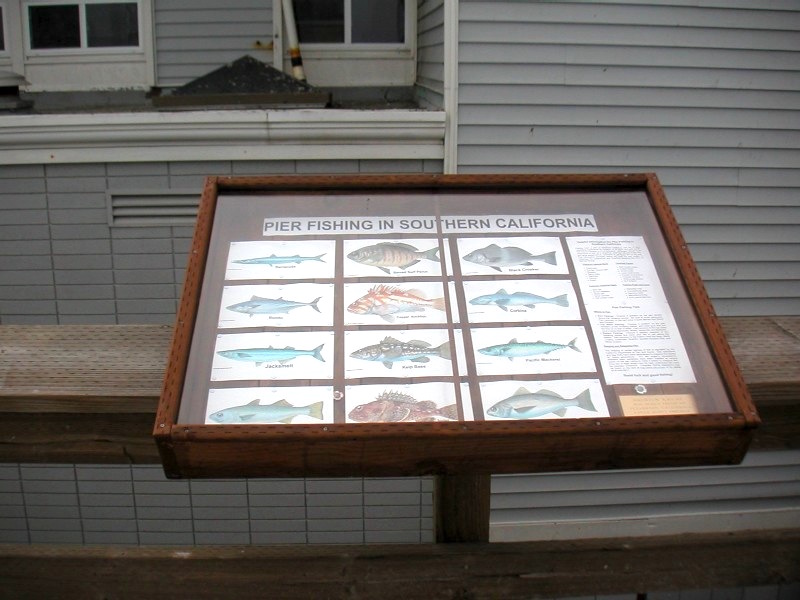
<*}}}}}}}}}>< — I was at Newport during a run of squid — and was lacking a squid jig much to me disappointment. This article gives a good account of such a run even though as a teacher I was told not to use the word “Oriental” for Asians. Times have changed.
Record Squid Run Attracts Eager Casters
Newport Beach — It was a perfect summer evening — windless and warm. At sundown, Oriental fishermen swarmed over the Newport Pier. Someone shouted: “Here they come.” Then the excitement began. Hundreds of lines were cast in an attempt to catch a school of giant squid.
Giant squid, native of Japan, arrived on the Orange County coast in late June in what has been called one of the longest runs ever noted. The squid, 10-armed sea mollusks, are on a 30-year spawning cycle. They won’t return here for approximately 35 to 40 years according to Nick Phoenix, owner of the Newport Pier Tackle Shop.
“I’ve seen ‘em run four or five days,” Phoenix said recently. “But I’ve never heard of a run like the one we’re having.” The squid started running June 26 and while now slowing haven’t stopped.
“We’re expecting a run heavier than this one sometime soon,” added Chuck Beriotti, a tackle shop employee. “Another group has been spotted just north of San Diego.”
The squid have been spotted throughout Southern California, but are most numerous at Balboa, Newport and Huntington Beach piers, according to Phoenix, a 20-year fishing veteran. We’ve been averaging 1,500 fishermen a night,” Bertotti said. “Ninety percent are Oriental.”
Squid is an Oriental delicacy. It is usually purchased at Oriental markets. But not this summer. “We don’t know when we would have a chance like this again,” said Herb Yamamoto, a Japanese-American from La Palma. “So while the catching is good we might as well catch them.” A veteran fisherman hauled in enough squid to fill three or four trashcans. But most fishermen caught about 20 a night. Squid not used immediately are frozen.
Phoenix said unusually warm ocean currents in Mexico have prolonged the run. The squid run from sundown to sunup, but never during daylight hours.
“There’s really no trick to catching them,” Yamamoto said. “Lower the fishing line five or six feet under the water and move it to attract them.” Phoenix added: “Squid are attracted to the lights of the pier.”
There’s no need for live bait, although squid do eat small fish. Yamamoto said a squid jig, with seven different colors, is an excellent fishing device. There was a scarcity of jigs but that was not the only problem the squid run caused. “One night it was so crowded you couldn’t walk out here,” Bertotti said. “A man suffered a heart attack and we couldn’t even get the ambulance close to him.” “It’s like Little Tokyo out here. They’ve even had special charters busing Orientals in,” he added.
“I wouldn’t be surprised to see Orientals from San Francisco or Hawaii come here just for the squid,” Yamamoto said. “This is a big thing to us.” “They want all they can get,” Phoenix said. “We’ve had to keep our boys on guard to keep the peace out here.” Angel Alvarez, 22, another tackle shop employee, added: “Most of the problems have been arguments over tangled lines. They’re practically on top of each other when the squid start hitting.”
Yamamoto said it’s hard to predict a run. “Squid are funny: they come and go.” But once squid hit, the catching is easy. They don’t put up a fight like most fish. Although weighing anywhere from one to six pounds, the squid can be pulled in directly, once hooked. “But there is a challenge to it,” Yamamoto added. “It’s more than fishing for food. I’m out here because it’s relaxing and fun. I’m on vacation right now.”
However, most fishermen, many with families, were here for one reason — to catch a good-eating seafood. “Squid can be cooked in many forms,” Yamamoto said. “Orientals like it raw or cooked with soy sauce. It can be boiled or deep-fried.”
Squid also is used to make jewelry. “Orientals use the eyes to make shiny necklaces,” Bertotti said.
Whatever the reason, everyone agreed that fishing for squid was fun. “Just another one of those perfect summer evenings,” said a Chinese youth as he pulled in another one.
—Elliott Almond, Los Angeles Times, July 20, 1976
<*}}}}}}}}}>< — A small plaque sits near the entrance to the pier. It is California State Historic Landmark #794 and encapsulates a long story in a few words: “12/04/96, #794, McFadden (Newport) Wharf, The original wharf at this site was completed in the winter of 1888-89 and was connected by railroad with the hinterland in the winter of 1890-91. It served as a shipping and distributing point for Orange, San Bernardino, and Riverside counties until 1907, and provided the nucleus from which developed the city of Newport Beach.”
<*}}}}}}}}}>< — Never forget that big sharks occasionally do enter the local waters.
Newport Beach Pier — On May 6, 2004 at “Dorymans” on the north side of the Newport Beach Pier, Tony Banzuelo reported: “I had been surfing for about 30 minutes, when I noticed the Newport Beach Harbor Patrol boat approach surfers approximately 80 yards north of me. As I paddled towards the patrol boat, the boat pulled away before I could hear what was said, so I turned around and headed back to my spot next to the pier. As I was approaching the pier, I looked over my right shoulder to keep surveillance on any oncoming set waves. I saw some set waves approaching, so I spun around and headed toward them. That is when I saw the silhouette of a black colored shark, 6’-8’ long, approximately 30 yards ahead of me. It had a large single dorsal fin and that’s all I needed to see! I spun around, caught a wave, and rode it to the beach. I looked up the beach to see that many of the other surfers had exited the water. I did not make contact with any of the other surfers.”
—Pacific Coast Shark News, 2004
There is a reference in Great White Sharksby A. Peter Klimley and David G. Ainley. They mention a 1.307 meter-long (or 51.5 inches) white shark being taken from the Newport Pier on June 12, 1985. That shark, as well as the one mentioned above, would have just been a baby. Of course the 14-foot-long “man-eater” taken at the pier in 1923 wasn’t a baby nor was the shark that bit a woman swimming at Newport Beach in 2016 (wounds that suggested it was a great white over ten feet in length). The big sharks are undoubtedly out there even if the sightings are rare.
Of course some years, usually El Niño warm-water years, may also see some other big sharks. One such occurrence was in October 2015 when a two-mile stretch of Newport Beach, a mile on each side of the pier, was closed to swimming after the sighting of an 8-foot hammerhead shark near the pier. The shark didn’t bother anyone and after the six-hour closure swimmers were allowed back into the water. March 2017 saw another closure of the Newport beaches after an 8-foot-long shark, assumed to be a great white, was spotted swimming about 200 yards off the shoreline.
<*}}}}}}}}}>< — California Fish and Game Bulletin #96 in 1953 stated: “There have been two features of the fishing at Newport that have attracted notice to the town. The most unique is the open air fish marketing on the beach, the only place in the State where this practice is followed. A dozen outboard skiff setliners fish off Newport the year round. At the end of a trip they pull their skiffs up on the sand, fillet the catch and sell direct to tourists and housewives. Several of these fishermen smoke the unsold catches and this processed fish is later offered for sale from the skiff markets. The other feature was the seining for jack smelt on the beach near the town. Each end of the long seine was pulled to the beach by a horse trained to make a slow steady pull by leaning forward into the harness with no jerking or straining. Other species of fish caught incidental to the jack smelt were released alive from the net. This beach seining operation ceased about 1933 (because of marketing conditions for the catch) thus depriving visitors of a most interesting spectacle… In addition to the large number of commercial fish boats sheltered in this bay, there is a fleet of privately owned sport fishing boats. In 1952 some 15 party boats and 121 charter boats were operating here. A Sportfishing barge was anchored off the town and the public pier was either dotted or crowded by ocean anglers. Another pleasure pier is located at Balboa.
<*}}}}}}}}}>< — The dory fleet that sits next to the pier is a unique and long-lived tradition that started back in 1891. Life is tough, both as far as the work itself and the effort to make a profit. However, the dory fishermen seem to love it; it’s in their blood. However, the modern world and increasing regulation are sometimes both a challenge and a threat.
Fish Story Has Happy Ending for Dory Men
In a decision that could help the beleaguered Newport Beach dory men, federal regulators have canceled restrictions for two types of fish the historic fleet has depended on for years.
The National Marine Fisheries Service has lifted a West Coast ban on thornyhead, as well as size limits for sablefish caught south of Point Sur, near Monterey Bay. Both fish have been a staple of the dory fleet’s rustic market off Newport’s McFadden Square.
Federal regulators said fishing for thornyhead was mistakenly prohibited in June when the government took emergency action to halt commercial fishing for popular varieties of rockfish commonly sold as red snapper. The ban was lifted July 25 for thornyhead, a species of groundfish, or bottom-dwelling fish, covered with long and short spines.
On Thursday, the Fisheries Service also lifted a size restriction of 22 inches or greater for sablefish, also known as sea trout.
Officials said catching thornyhead and smaller sablefish in southern waters would not interfere with efforts to restore rockfish populations, particularly bocaccio, which has been devastated by overfishing.
“The restrictions have been lifted and the corrections made. This will help the dory men, big-time,” said John DeVore, a groundfish manager for the Pacific Fisheries Management Council, a coalition of government and industry that helps set fishing policy.
The fleet, based at the foot of Newport Pier, has been in decline for more than a decade. As late as 1990, 15 to 20 men regularly operated out of the group’s headquarters and fish market. Now there are no more than six.
The remaining dory men and their families had feared the new rockfish regulations would eventually destroy their unique lifestyle, which has been a part of the Newport Beach waterfront since 1891.
“If the changes allow the six or seven families to continue their livelihoods, it will benefit the city tremendously,” said Newport Beach Mayor Tod W. Ridgeway. “The dory fleet has economic and historic value. It is critical to our image.”
Last month, the city met with the dory men and sent a letter on their behalf to the Fisheries Service and the Pacific Fisheries Management Council.
—Dan Weikel, Los Angeles Times, August 3, 2002
Dory Fleet keeps proud fishing heritage alive
By noon most days, the Newport Beach Dory Fleet’s marketplace has quieted down, save for a few tourists who come by and snap photos of the historic wooden structure.
In the mornings though, just before sunrise, the approximately 100- by 75-foot market comes alive. Customers chatter. Knives clatter. The salty smell of fresh fish permeates the air. Nearly a hundred customers mull about in the open-air structure, picking and prodding at the fish with hooks.
“I’m just trying to bring them out as fast I can,” Scott Breneman says, as he hauls a tray of plump, slimy black cod from his locker to the dark sea green display boat.
His dad, Rob Breneman, stops by a couple hours later to pick up some black cod and deliver it to a local caterer. This isn’t just a business for the Costa Mesa residents — it’s a way to keep their family’s legacy alive. Rob, 53, is a relic of the Dory Fleet’s renovated, yet tumultuous past; Scott, 31, is a glimpse of its present and foreseeable future.
Waves of technological and regulatory changes in recent years have made it harder for the Dory Fleet’s fishermen to stay in the business. And even though their fleet — named after traditional wooden boats with sharp bows and flat bottoms — has gotten significantly smaller over the years, the Brenemans and their fellow fishermen are not losing hope for the future.
Catching for the thrill of it — Rob Breneman is a third-generation fisherman. His maternal grandmother and step-grandfather fished with the Dory Fleet in the mid-1900s. Back then, the dorymen would row their wooden dory boats and tow them by horse through the sand to the market area, he said.
Rob started fishing crab when he was 18 years old. At 36, he joined the dory fleet as a fisherman. “I thought I was a cowboy — I thought (fishing) was pretty cool,” he said. “It was a lot of fun, you know, rolling my boat up (to the marketplace).”
Rob’s father was a master craftsman. So, the young fisherman blended his love for crafts and fishing by building dory boats with his brother Rick in their free time. The fleet was very competitive at the time. The marketplace’s layout changed almost every day because of one rule: the spots were awarded on a first-come-first serve basis.
By the 1990s, most of the men had jeeps, pullers and the latest technology, which meant they could come back earlier and had better chances of getting a good spot to sell their fish. Rob resisted the changes initially, but had to adopt them to keep up with the competition. “I hated all that stuff,” he said. “I liked it the old-fashioned way — pulling your boat in. That was tradition down here and I liked that.”
Carrying on the fleet’s legacy— The Dory Fleet has been Scott Breneman’s second home for most of his life. A week after he was born, his father brought him to the fish market and weighed him in a scale.
Growing up, Scott helped his dad at the dory fleet, but didn’t really consider fishing as a career option. He wanted to go into physical therapy, so he headed off to Chapman University to pursue a bachelor’s degree in biology.
After graduating though, he realized he didn’t want to go back to school. For a couple of years, he and a friend imported boats from Mexico and sold them in the domestic market. The business slowed down around 2005 and Scott decided to try his hand at commercial fishing instead. At the time, Rob was taking a break from fishing because his back was worn out from the long hours on his small dory boat. But when he heard his son wanted to start a commercial fishing business with him, he was eager to jump right back in the water. “I said, ‘No problem, let’s go,’” he said.
The father-son duo had a lot to learn before they could head out their first commercial fishing expedition as a team. Commercial fishing operations, including those at the Dory Fleet, have become much more sophisticated over the last few decades,” said Marci Yaremko, the state and federal fisheries manager for the California Department of Fish and Wildlife. Regulatory changes, intended to maintain fisheries and prevent overfishing, and improvements in fishing technology could help explain a sharp decline in the number of commercial fishermen, she added.
There were about 28 fishermen at the Dory Fleet in the 1980s.Now, there are eight. “It’s no longer the Wild West out there, where you could just go and get a boat and go start fishing,” Yaremko said.
The type of fish sold at the market varies by season. Rob and Scott typically fish rock cod and black cod during the summer. When he first started out as a fisherman, Rob would go out in four- or five-hour spurts and only about 10 miles out from the shore. Now, most of the pair’s fishing trips last 24 hours and require fishing between 50 and 80 miles from the shore. Scott plans the trips carefully; he has a wife, a 2-year-old and an infant waiting at home.
He usually uses his boat’s GPS and plotter to find his way through the water. His father takes a more old-school approach, using landmarks, stars and the compass to navigate. “My dad teaches me a lot about the old ways, but I still fall back to the electronics,” Scott said. “For me, I think it’s more efficient.”
Although many of them have switched from dory boats to commercial boats over the years, Scott and his fellow fishermen said they try to blend the old and the new in their business practices. They want to make sure the Dory Fleet lasts.
Tommy Tupman, the fleet’s newest member, goes fishing several times a week and looks for seafood that the fleet’s other fishermen don’t already sell. The goal is to reel in more customers by selling a large variety of fresh fish in one place.
Many of the fishermen have also started using social media to promote the market in hopes of getting young people hooked on their fish, Tupman said. The city is helping out, too. In its budget for this year, the Newport Beach City Council allocated $50,000 for maintenance and repairs on the Dory Fleet marketplace.
“The Dory Fleet has been a long-standing component of the community and it’s a part of the city’s heritage,” said Kim Brandt, the city’s community development director.
Though he’d like to see the family’s legacy at the Dory Fleet continue, Scott said he thinks about his kids choosing a different career. “I’d like to see them have it easier … (Fishing) takes a toll on your body — you know, those long hours standing up all day and hauling fish around,” he said.
Regardless of what happens with their family’s ties to the fleet, both Scott and Rob said they’re pretty confident it will continue to come alive in the mornings — as it has since 1891. “(The Dory Fleet) means a lot to me,” Rob said, gazing at the busy market from a distance. “It means even more to me now because my son Scott’s here, doing the same thing I was doing … this (fleet) is my life.”
—Naheed Rajwani, Orange Coast Register, March 2, 2014
<*}}}}}}}}}>< — One of my favorite restaurants sits just across the McFadden Place parking lot from Newport Pier. It’s the Crab Cooker and a restaurant I’ve visited for over 50 years, a place I try to visit every trip to town, and a place that I heartedly recommend. I always start off with a bowl of the Manhattan-style clam chowder (some of the best to be found anywhere) and the only problem is saving room for the main meal after woofin’ down the chowder, some bread sticks, and possibly a cracker ball or two (or three, or…). But do save room for the main course because the fish, shrimp, scallops, crab, etc. are all good.
Not content just to eat his food, I was also audacious enough to ask the owner, Bob Roubian, for a recipe for Pier Fishing In California, 2ndEd. I was writing the section on grilling fish and having always loved his grilled fish I asked for a recipe for a fish that would be caught from the Newport Pier. He supplied a recipe for sculpin (scorpionfish), one of the most common fish from the pier. Unfortunately Bob has passed on but the restaurant, that underwent an extensive renovation in 2018-2019, remains. Herein, an interesting article about the restaurant (although there are several errors in the newspaper story on a great white shark mentioned in the article).
From popcorn to fish including a day at the beach — Novelty singer goes gold and cooks up another hit
The Popcorn Song — I’m too pooped to pop, just layin’ here fryin’ and I aint lyin’. The salt and butter is ready, and the fire is hot, but I just seem too pooped to pop. ~Bob Roubian
Bob Roubian’s covered startup costs of the Crab Cooker Restaurant with sales of “Too Pooped to Pop.” Like the star athlete who studies for his business degree and plans for an alternate career, songwriter Bob Roubian, transformed the proceeds from his 1954 hit song, Too Pooped to Pop, into a fish business in Newport Beach, CA.
With the burgeoning population in Southern California and Roubian’s commitment to serve the world’s best fish, his business has become a world-renowned restaurant and a travel destination for tourists. According to Steve Bolton, Roubian’s nephew and restaurant manager, The Crab Cooker provides an authentic and unique culinary experience to between 5,000 and 6,000 customers a week including world travelers, celebrities, businesspersons in three-piece suits, and locals in bikinis.
According to Steve, even the President once thought to eat at The Crab Cooker. Steve said when President Nixon was in office, the president’s staff called to make reservations. “My uncle explained the restaurant has a first come first serve policy and does not take reservations. He said he would love to have them or they were welcome to buy something to go.”
Steve Bolton, restaurant manager, wears beach city attire and gold nugget memorabilia from his 10 years in Alaska. Steve said the first come first serve policy holds true even for family and friends. “When I come to eat, I wait like everyone else. Even my grandmother graciously waited her turn to be seated to eat at the Crab Cooker.”
Countless magazine endorsements, and most importantly, word of mouth from happy Crab Cooker diners affirm year after year the popularity of the restaurant.
Dedication to quality and serving their customers are the two characteristics that Steve believes sets The Crab Cooker Restaurant apart. “If you like seafood, it is very difficult to beat the quality and prices our restaurant has to offer. Everything on the menu is unique.” …
Dory fisherman snagged the 14-foot white shark that now hangs from the ceiling of The Crab Cooker Restaurant in Newport Beach. “Other than our Crab logo, many people identify us by the shark that hangs in our dining room.”
Roubian designed the décor, which includes a fire engine red exterior, café tables, and a 14-foot shark hanging from the ceiling… jaws gaping as if to say turn about is fair play.
According to a newspaper article displayed on a wall in the restaurant, dated January 29, 1960, two dory fisherman were 100-yards out from shore by the Newport Beach pier when they snagged, in their sea bass nets, the 1,000 pound white shark; the largest caught to date on the west coast.
Roubian’s commercial fisher was nearby and the crew removed the shark from the tangled nets. Roubian then set it on display in front of his restaurant; dorsal fin waving in mock greeting to the crowds of 20,000 onlookers who jammed the streets for three days…
Steve said in the past, the fishermen pulled right up on the beach behind the restaurant, but now they land at Dana Point. Items like albacore come from northern Californian and Oregon where the fishermen unload their boats and send the fish down to the restaurant…
Roubian moved into the restaurant’s existing building in 1960, part of which was originally the Bank of Italy and later became the Bank of America. At that time, Newport was a place just to come for the weekend or the summer, there wasn’t much of a year-round population base. In those days, the restaurant only served meals on Friday, Saturday and Sunday nights, and throughout the rest of the week, it was a fish market…
When coming to eat at the Crab Cooker in Newport Beach, Steve recommends seeing the beach. “We have some of the nicest beaches around here. People come to enjoy the beach and the weather… Don’t forget to pick up a copy of Roubian’s music cassette titled “Fish Songs.” Roubian still writes and entertains customers with his music.
—Janet L. Hanson, RURALNORTHWEST.COM, May 6, 2005
Another nice mention was the following (although I would not characterize it as a dive):
America’s favorite seafood dives
It’s Coastal Living’s annual guide to the top eateries where food is fried, broiled, grilled or otherwise slapped on butcher paper for your finger-licking, crab-cracking, French fry-munching pleasure. This year, winners (and finalists) were chosen by readers.
The Crab Cooker, Newport Beach
Citing “consistently great food,” readers back up the menu’s promise of the world’s best clam chowder. Scallop-and-bacon skewers and hot king crab claws are full of flavor, too.
—Steve Millburg, Coastal Living, July 18, 2011
<*}}}}}}}}}>< — What’s life like “under” the pier? Although never a diver myself, I always enjoy stories from divers talking about what they have seen while diving under a pier. Here’s one story—along with some video references.
Newport Pier— For many years I’ve heard about diving under the Newport Pier. I was never keen on the idea. It’s surrounded my surfers and sand, and protected by a curtain of fishing poles. Three years ago, my friend Jim, finally talked me into it. “We’ll make a quick dive before work,” he said. I work 10 minutes from there. So what, I’ll be a little late?”
Upon arrival, my expectations held. Lots of surfers, lots of sand and lots of fisherman. The upside was, it was a beautiful summer morning and I was playing a little hooky from work. The parking is very close to the pier. There are no stairs. The walk over the sand is short, and there are showers right next to our parking spaces.
This is probably the easiest Southern California beach dive you can do. We first checked conditions by walking to the end of the pier and looking down at the pilings. The visibility looked unexpectedly nice. Easily 15 feet vertical. Our entry was just next to the pier.
A quick shuffle through the surf and we then finned under the pier and made a surface swim to the beginning of the rectangular platform at the end. We dropped down 24 feet to the bottom. It was bright and sandy behind me and dark and ominous in front of me. My initial reaction was that this was a wasteland. Lots of discarded junk and fishing line. There was almost a fence of knives surrounding the pier.
It didn’t take long to make a quick recon of the entire dive area. When I finally settled down and put on my macro eyes, an explosion of life was in front of me. This is an arduous environment, subjected to high surf and the seasons, yet there was a proliferation of life under the pier. After my initial dive, I told Jim that we should make this a weekly event. So started my quest to video document this environment for a year. We meet every other week or so. Two-thirds of the time, the visibility at the end of the pier made us skip the dive and arrive early at work.
The late spring and summer months are the best under the pier. Bryozoan carpets the bottom making a nursery for juvenile fish, crabs and nudibranchs. Bundles of fishing line make a home for pipefish. In my 30 years of diving, these were the first pipefish I’ve seen in Southern California. Empty clamshells make a home for bay blennies. A discarded PVC pipe makes a home for sarcastic fringeheads. An empty shell makes a home for a small octopus. Crabs of many flavors enjoy the bounty of discarded fileted fish from the fisherman above
Fall months can have the best water visibility. Life is down a bit, but strange things can be sighted. Male sarcastic fringeheads have established their territories in moonsnail shells or PVC pipes or bottles. They have wooed females to lay eggs and are on high alert. They WILL bite your finger to prove it. I’ve found a small group of juvenile flag rockfish, a rare find of a deep water resident. Schools of baitfish can swarm the pier and blot out the light. On one magical fall morning, I could see the sand from the end of the platform.
A night dive is eerie in every sense. It’s the “Night of the Living Dead.” Red crabs that have been hiding in the sand all day, come to the surface. When you put your hand down on the bottom, it would start to move as crabs emerge from the sand. The bottom becomes covered with them. They are the night cleanup crew. This was of my freakiest night dive ever. I should make this a Halloween tradition.
The winter storms scrub the pier clean of the life holding bryozoan. It becomes an apocalyptic wasteland with the bottom covered in clam shells. Mostly empty, but not all. The ever-present moon snails search for the live ones for their final coup de grace. They leave their telltale bore hole, showing that they succeeded.
—Walter Marti, California Diving News
<*}}}}}}}}}>< — Favorite videos of the Newport Pier—the following videos give life to the words of the above diver.
A Year Under the (Newport) Pier —
http://diver.net/waltermarti/YearUnderThePierLOW.htm
Newport Pier- November 2012 —www.youtube.com/watch?v=ZjQOFeqgSRI
A Day in the Life of Newport Pier — http://www.youtube.com/watch?v=zZe6DwgYLSk
Newport Pier — http://www.youtube.com/watch?v=dRfG3Uz13x0
Newport Beach Pier — http://www.youtube.com/watch?v=PSZap8g9lao
<*}}}}}}}}}>< — Starting in the early 1990s there were calls to restrict the fishing hours on the pier—or perhaps even close the pier to fishing altogether (although this is a WCB pier and closure would be illegal). The issue would drag on for years and lead to both acrimony and resentment that have lasted for nearly two decades. Two main issues precipitated the calls for restriction.
One issue was violence at the beach. Gang violence erupted during a rap concert at the foot of the pier on July 31, 1993. One person was shot and killed and another was injured. Most people, including the police, felt it was an isolated incident (although some felt that the newly enacted 10PM curfew at Huntington Beach prompted the gangs to move south to Newport).
However, a second shooting that took place shortly thereafter—on September 19, prompted increased calls for a curfew.
Violence Threatens a Nighttime Haven: Recreation: Anglers and other denizens of Newport Pier treasure the spot, but shootings may mean its closure.
NEWPORT BEACH — Late Monday night, when the gangs weren’t banging on the Newport Pier, Chris Garcia proposed to his sweetheart. She said yes, and they drove back to San Bernardino.
From his perch near the telescopes, Bruno Madrigal said the gentle rolling of the nighttime surf never fails to spark thoughts of his family in Cancun. At least a couple of times each month, he comes just to stand and stare across the water.
And Michael Aresta, his teeth chattering in the chilly air, tossed his line into the sea, praying only for the mackerel to bite. “When the tide changes,” Aresta said, leaning far over the scarred wood railing, “the fish go wild. . . . Some nights, they make me look like a professional.”
It was well after midnight, a time—until recently—when crime on the pier was measured by an occasional overhead cast or smuggled beer in a squid cooler. But this is Southern California, and the gangs have become all too frequent visitors to this nocturnal paradise.
So unnerving was an incident last weekend, when gunfire wounded three and had some anglers diving for cover, that the city has threatened to shut down one of the last all-night entertainment refuges on the Orange County coast. The City Council is expected to discuss the possible closure next week.
That prospect distresses the pier’s faithful denizens, whose ranks were noticeably thinner than usual earlier this week. Most nights, the outer railings are lined shoulder-to-shoulder with anglers, their gazes fixed on their bobbers in the water. On this night, however, even Joe Montana’s debut with the Kansas City Chiefs on national television couldn’t explain the absence of so many of the hard-core regulars.
Monday night and into the wee hours of Tuesday morning, police officers made regular passes along the long, narrow stretch of concrete in a show of force not seen since a similar crime eruption in July that left one person dead. Police are expected to continue the increased patrols indefinitely.
Among the 30 or so anglers who had settled in for the long night, only passing reference was made to the latest shooting, in which one teen-ager has been arrested. (Two of the wounded have been released from area hospitals, and a third victim remains in stable condition.) Some were almost blasé about the incident and speculated about its causes.
But others worried that it might ultimately deprive them of a treasured haven.“We’ve been coming here for years,” said 44-year-old George Dewey. “I know every inch of it… I consider it my home. If they close this down, they close people like me down.”
Thomas Easley of Costa Mesa said he wasn’t present early Sunday morning, but he is a regular here for sure. “I was here the night before, I guess,” he said, tugging at his black baseball cap. “I remember, because the sharks were biting real good that night… You know, it ain’t no big deal. These days, you can get shot just riding the down the freeway.” “It was probably some drug deal gone bad and somebody came up here looking for somebody to pop,” he said.
Steps away, Aresta’s hunt for mackerel had improved by the minute. Although not able to keep the amazing pace of Charles Chen, who was hauling up two at a time, Aresta was pushing for a respectable finish even though his girlfriend, Andrea Woods of San Bernardino County, had long ago retired to the car. “I think she is really mad at me. I promised her we would leave by 11:30 p.m.,” Aresta said at about 1 a.m. “I can’t leave while they are still biting.”
The late hour clearly was wearing on 3-year-old Sara Reid. Earlier in the evening, she couldn’t have been more excited as she waved a rubber fishing lure in her mother’s face. Hours later, her mom was gently rocking the child in her lap, oblivious to both the late hour and news of the recent violence.
“We didn’t hear about it until we got here. We really aren’t concerned about it,” said Teresa Reid, who with her husband and other daughter, 9, traveled from West Covina just to fish from the pier. “We come out here because it’s quiet, and it’s one of the only places that stays open all night.”
One of the few other places open all night is the Seaside Donut Shop at the base of the pier. Sean Smith was standing outside it on Monday evening, in about the same place where the first shooting happened in July. “I always thought this was a real safe place,” Smith said. “But when the first shooting happened, I almost ran right into the guys who did it. There were people lying in the street that night.”
—Kevin Johnson, Los Angeles Times, September 23, 1993
Don’t Surrender the Pier to Gangs
It will be ironic if the rest of us are shut out of the Newport Pier as the youth gangs roam free on our streets. There are already very few facilities where a young person can go after dark, and closing up the pier will potentially foster more mischief elsewhere.
Certainly, our city can keep a manned patrol car or substation at the pier entry around the clock to maintain order instead of shutting down the pier at night. We should also be awakened by the fact that a 13-year-old killing people randomly in cold blood is far more dangerous than a 30-year-old that killed for love or money.
It is time our society and lawmakers discard the naive notion that those murderers and criminals under the age of 18 are somehow less responsible for their crimes, no matter how heinous. There is no reason to wipe these young monsters’ slates clean at age 18 simply because their crimes were committed at a younger age. We, the people, deserve nothing less than the truth and the right to walk our streets without fear of getting hit by a bullet.
—John T. Chiu, Los Angeles Times, September 26, 1993
The violence seemed to play right into hand with earlier calls by the local merchant’s association for a curfew on the beach and pier. Their original complaints, led at least in part by the pier concessionaire (the owner of the restaurant that sits out at the end of the pier), was what they felt was the unsightly and smelly condition of the pier, especially the area out at the end of the pier (a.k.a. best fishing area and area adjacent to the restaurant).
The source of the problem was seen as the fisherman themselves, at least those whose trash and fish guts frequently littered the pier. The city, at least in part, seemed to along with their thoughts and declared it to be a problem that would no longer be ignored or tolerated. Would a curfew be imposed and would the pier be closed for part of the night?
Newport Beach: Council to Debate Proposals for Pier
The City Council on Monday will debate the future of the Newport Pier, the site of two apparent gang-related shootings in the past four months.
“I think the pier at night had become a scary area,” Councilwoman Janice A. Debay said. “It is something that is remote and dark… The idea here is to make it brighter and happier.”
The recent shootings there have created a sense of urgency about the future of the pier, a matter that has been under consideration for some time. Closing it at night is one of several ideas for revitalizing the area proposed during recent meetings involving city officials and residents and business owners. Other proposals include closing the pier periodically for cleaning, and allowing in street musicians and vendors.
The Newport Pier is known as one of the best places in Southern California to dangle a hook. Anglers can be seen sitting on small benches around the clock… The pier’s popularity can be seen in the large number of fish heads and bait left lying around.
Debay said that in the Monday meeting the seven-member City Council will consider proposals to improve lighting in the parking lots and to make sure the pier is clean to create a more comfortable and safe environment. The council will study the issue, but no action will be taken Monday.
“We have to get the fishermen to understand and to work with us and keep the area clean,” Debay said, adding that city officials have designed a sign asking anglers to clean up after themselves.
On July 31, gunfire erupted between suspected gang members at the foot of the pier; one man was killed. And on Sept. 19, an alleged gang member opened fire, wounding three people.
After those incidents, restaurants near the pier suffered a rash of dinner-reservation cancellations, she said.
—Bob Elston, Los Angeles Times, October 23, 1993
After several meetings, impassioned testimony from anglers, letters supporting the anglers (including one from me), and considerable organization by local anglers, a compromise seemed to be met. The city agreed to more cleaning of the pier and fishermen joined together in an effort to keep the pier clean (as well as instruct newcomers to the pier about regulations). Conditions on the pier did improve and, for a period of time, the city backed off on reducing the hours.
No Curfew Imposed on Newport Pier
NEWPORT BEACH — After listening to impassioned pleas from fishermen and residents, a unanimous City Council voted Monday to close the Newport Pier for a few hours each week for cleaning, but not to impose a nightly curfew.
The unanimous decision was a compromise between homeowners and anglers, who did not want a curfew, and merchants, who wanted something done about vagrants and about the trash and fish parts left on the pier.
The ordinance gives City Manager Kevin J. Murphy authority to close both Newport and Balboa piers periodically for cleaning. Initially, the closure would be between 4 and 6 a.m. on selected days, Murphy said. The hours are flexible, however.
The ordinance also prohibits sleeping bags or cots on the pier between 9 p.m. and 9 a.m. It also prohibits anglers from cleaning fish or putting entrails on the pier or over the railings. And it prohibits placing bait on the pier.
The council will take a final vote on the curfew Jan. 10. It would become effective 30 days later. City officials, who decided last spring to close the beaches at night, have been wrestling with the idea of closing the pier. But they resisted the idea of a curfew because the pier for many years has attracted people on late-night strolls. It is also a renown spot for anglers.
But the issue took on an urgency over the summer when gunfire erupted on or near the pier. On July 31, gang members traded gunfire at the foot of the pier and one man was killed. On Sept. 19, an alleged gang member opened fire, wounding three people.
Resident Robert Roubian, 87, told the council Monday, “Ever since the pier has been in the custody of Newport Beach, and that’s been about 110 years, they’ve only had one to two shootings that I can recall. . . . Please, I urge you to be patient. Don’t take way our moonlight walks and our freedoms.”
Joe Imbriano, 25, of Newport Beach, who implored the council not to set a curfew, said people “look forward to fishing the pier at sunrise. There’s plenty of mackerel and bonito runs at that early hour. . . . It would take away something very dear to me and other people who can’t be here today who probably did not even know that the council was taking this up as an issue.” He added, “In my 15 years of fishing on that pier, I’ve never had a problem with crime, and I’ve never been assaulted.”
Although Mayor Clarence J. Turner voted in favor of the ordinance, he said he remained unconvinced that it would “stop the growing social problems that we are finding more and more on our pier.” “I heard lots of you this evening say how it was in the old days,” Turner said. “In the old days, Orange County only had 500,000 people here. Now, we have about 2.6 million. And with our growing social problems, we need to be making some tough choices.”
—David Reyes and Lily Dizon, Los Angeles Times, December 14, 1993
Alas, the work of anglers to keep the pier clean was not enough and problems continued. Local businesses continued to complain and eventually a change to the law was made.
Newport Beach: Law Aimed at Cleanup of Piers Wins Backing
The City Council unanimously supported a change in the law that will let the city manager limit pier fishing and close Newport and Balboa piers periodically to discourage littering and improve appearances.
Public support for the plan, designed to eliminate the litter from bait, fish and food wrappers, also was strong. City officials have traced the debris to anglers and transients.
“The Central Newport Beach Assn. has been in favor of doing something about the foul conditions on Newport Pier, and sometimes Balboa Pier,” said association president Thomas Hyans. “We have enough scofflaws now,” he said. “We have an 8 m.p.h. speed limit on the (beachfront) walk that no one ever pays any attention to. We have signs at McFadden Square saying, ‘Walk your bicycles and roller-blades.’ No one pays attention.”
Rush Hill, president of the city’s Economic Development Committee and vice-chairman of the Newport Pier Assn., urged the council to approve the change to help business owners. “We still live, at Newport Pier, with the very fundamental problems of cleanliness and safety,” he said.
The piers are closed from 6 to 8 a.m. daily for cleaning, with little apparent resistance from the fishing crowd or anyone else, City Manager Kevin J. Murphy said.
Merchants and residents have told city officials studying the situation that visitors and residents shy away from the piers because of their unseemly appearance. Merchants also believe the pier conditions are sending tourists elsewhere to spend their money.
The council, with Mayor John W. Hedges absent, voted 6 to 0 for the change in the law.
—Holly J. Wagner, Los Angeles Times, January 11, 1995
Nevertheless, given the continued opposition from anglers, and the attempt by anglers to keep the pier clean in an organized manner, the city manager agreed to a further compromise. Perhaps it only stalled the inevitable but both sides were working for a solution.
Angling for Solution to Pier Debate
Fish guts and flying hooks will be discussed Friday at City Hall as anglers, homeowners and city officials meet to determine how to keep the Newport Pier clean and safe.
For nearly two years, the city and people who fish from the Newport Pier have been debating how to keep the pier clear of fish entrails and flying fishing hooks. For a year, a group of anglers, who call themselves the Volunteer Newport Pier Patrol, have been monitoring the pier and reminding people to clean up their mess after fishing.
Early last year, the council gave City Manager Kevin J. Murphy the authority to close off all or part of the pier if the fishing-related mess persisted. State law, however, prohibits banning any group from using city piers.
More than a dozen anglers countywide met last Sunday to prepare for Friday’s meeting. “Our position is to leave things the way they are,” said Joe Imbriano, a Newport Beach resident who organized the fishing hobbyists.
The people who fish at Newport Pier regularly are not the problem, Imbriano said. “The problem is a lack of police enforcement and lack of maintenance on behalf of the city,” he said.
Murphy, who will host Friday’s meeting, will later offer a recommendation to the City Council. “There’s clearly a problem from our perspective. Friday’s meeting will bring this issue out in the open,” Murphy said, adding that some of the angler’s written proposals concur with some of the city’s solutions to keeping the pier clean…
—Enrique Lavin, Los Angeles Times, January 31, 1996
In the end, the compromises and delays came to an end and the pier hours were reduced.
Council Votes to Close City Piers at Midnight
The City Council voted Monday to close the city’s two ocean piers at midnight, a move aimed at revitalizing the pier areas and keeping them clean and safe.
Fishermen, homeowners and merchants have been quarreling over the issue for more than two years. The council gave City Manager Kevin J. Murphy the authority last year to do whatever was necessary to keep the piers clean.
Two longtime Newport Pier anglers, Anna Marie “Sue” Brassil and Richard Beunger, subsequently launched a campaign to encourage anglers to pick up after themselves and stop overhead casting, another point of contention. “I’ve spent $800 to $900 showing our intent: the right to fish, and a clean area,” Beunger said Tuesday.
With Mayor John W. Hedges and Councilman Dennis D. O’Neil dissenting, the council voted 5 to 2 to close the Newport and Balboa piers from midnight to 5 a.m., to increase police enforcement and to work with business groups that have complained about fish entrails and other litter on the piers.
Some homeowners, though, were not happy with the outcome. “The City Council did absolutely zero. We’ve gone nowhere. The fishermen that went to the meeting are not the same people that cause the problem,” said Tom Hyans, president of the Central Newport Beach Community Assn.
Murphy had recommended installing surveillance cameras on the piers as crime deterrents and had estimated that four cameras, two for each pier, would cost a total of $28,000. The council rejected that as too expensive.
Beunger, a Santa Ana resident who said he has been fishing from Newport Pier for 20 years, agreed. “With that money,” he said, “they can put it into the police kitty” and beef up enforcement of existing regulations.
—Enrique Lavin, Los Angeles Times, February 28, 1996
Although many anglers continued to protest, it seemed the merchants (and perhaps local non-angler citizens) had won. Since then anglers have begrudgingly learned to live without the late night shark fishing (and have missed much of the opportunity to catch the deep-water species that sometimes arise at night from the depths of the submarine canyon).
Newport Pier Fishing Curfew Starts Tonight
Newport Beach — No more fishing all night in this city.Beginning today, the city will close the Newport Pier from midnight to 5 a.m. in a move aimed at curtailing crime and reducing fish waste on the pier’s deck.
Although adopted in February, the policy did not go into effect until today. The curfew will also apply to the city’s Balboa Pier but won’t be enforced until a gate and signs are installed later this month, said Peggy Ducey, assistant to the city manager.
The curfew has validated anglers’ fears that they would be shoved off two of the reputedly best fishing spots in the state during hours that yield bountiful catches. A group of fishing enthusiasts, named the Volunteer Newport Pier Patrol, pleaded with other anglers for more than a year to clean up after themselves.
But city officials agreed with merchants and area residents, who complained that fish bait and entrails left behind by anglers diminished the attractiveness of the city and hurt tourism. Officials also said there was a growing problem with graffiti, other kinds of vandalism and public drinking.
After a month long study conducted by the city staff to determine the effectiveness of closing the piers, city leaders decided in February to reduce fishing hours. Last week, the city installed large signs and a wrought-iron gate at the Newport Pier’s entrance.
Many anglers on Tuesday praised the city’s move, saying the policy will affect only a few people who regularly fish past midnight.
“There will be a few ‘real’ fishermen who will be affected by this,” said Robert Anderson, 67, who has been fishing off the Balboa Pier for nearly 50 years. “It will affect mostly those who come here to drink and smoke funny cigarettes.”
But Chris Whitehouse, 17, who said he’s been fishing off the Newport Pier as long as he can remember, said the new hours bother him. He denied that late-night anglers are sloppy with their catch or vandalize property.
“Late at night or real early in the morning is a good time to fish,” he said, adding that summertime is the best time for night fishing. “But it has gotten unfriendly over the years, and there’s only about five of us who are crazy enough to fish that late anyway.”
On Tuesday evening, dozens of anglers lined the Newport Pier railing, some with catches of tar fish, sand sharks and shovel-noses. Many said they had not heard about the curfew. “I’m totally against it because that’s the time when the fishing is good,” said Colin Woodward, 19, of Fountain Valley. “It’s when I have to come out.”
Mike Tajima, 23, of Costa Mesa said people who don’t fish but enjoy the pier will be affected. “This pier is an institution. Couples come out here for a peaceful stroll. The city is going too far.”
But Ducey said Newport Beach officials hope the curfew will curtail crime and reduce fish debris, which city crews will clean up during the closed hours much like in San Clemente, where the pier is closed from midnight to 4 a.m. The Huntington Beach Pier is the only other one closed after midnight, until 5 a.m.
“Sometimes, the difficulty we have [is] during those late hours with unlawful activity,” said Linn Hughes, San Clemente’s marine safety and recreation manager. “It has really worked out this way… Daytime fishing is not a problem.”
Two years ago, the city imposed measures to keep the Newport Pier clean, including removing several wooden benches from the end of the pier. In addition, the city restricted anglers from cleaning fish or putting fish entrails on the pier or over the railings. The same ordinance prohibits sleeping bags or cots on the pier.
—Enrique Lavin and Davan Maharaj, Los Angeles Times, June 19, 1996
The fight and saga was over, at least for most. Some anglers remain bitter but as the years have passed most have simply forgotten both the fight and the special opportunity once afforded to local anglers.
In many ways the struggle to keep the pier open 24 hours was a microcosm of the issues confronting many municipalities and many piers in the ‘80s ad ‘90s; today only a very limited number of piers are open 24 hours, none in Orange County.
(This, by the way, is not the first time the pier was closed. More than a hundred years ago, August 24, 1889, to be exact, the Santa Ana Herald reported that Robert McFadden would be closing the wharf each day from 6 P.M. to 7 A.M. He said he was obliged to do it to stop wood thefts on the wharf. The paper was opposed! It said the action “prevents early to late fishing… not considered right… as likely to discourage reader use… it being more pleasant to pursue sport in the cool of the day.”)
Special Recommendation. Because of elevated levels of DDT and PCB in tested fish, the Cal OEHHA recommends that no more than one meal of locally caught corbina be consumed every two weeks.
Special, Special Recommendation. Because of the continued threat to additional restrictions on the pier we ask everyone to take special care to keep the pier as clean as possible. The pier now closes at midnight which to one who liked to fish the wee hours for sharks, and deep-water fish that might head to the surface at night, it was a bitter pill. But it’s still closed at night.
(This, by the way, is not the first time the pier was closed. More than a hundred years ago, August 24, 1889, to be exact, the Santa Ana Herald reported that Robert McFadden would be closing the wharf each day from 6 p.m. to 7 a.m. He said he was obliged to do it to stop wood thefts on the wharf. The paper was opposed! It said the action “prevents early to late fishing…not considered right… as likely to discourage reader use…it being more pleasant to pursue sport in the cool of the day.”)
Newport Pier Facts
Hours: Open from 5 a.m. till midnight.
Facilities: Restrooms are found near the entrance to the pier. Fish-cleaning stations, lights, and benches are found on the pier. There is limited parking (6-hour maximum with coin and credit card payment) located near the entrance to the pier. Rates vary by season, May-September $3.10 an hour; $1.05 an hour Oct. – April (free before 8 a.m. and after 6 p.m.) Other than early morning and late night, these pier parking spaces are gone fast. Be prepared to spend time looking for a spot at almost any other time.
Handicapped Facilities: Handicapped parking spaces near the pier entrance, a ramp leads up onto the pier and handicapped restrooms are available. The pier surface is concrete and the railing is about 36 inches. Posted for handicapped.
How To Get There: From the Pacific Coast Highway take the Newport Blvd. turnoff and proceed west watching for signs directing traffic to the pier. The pier sits at the foot of McFadden Place.
Management: City of Newport Beach.
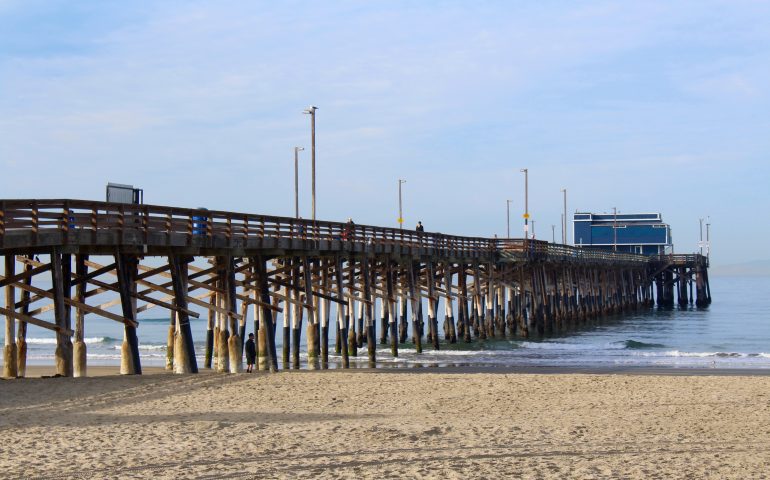
Wow! Your article has brought back a lot of memories for me. My name is Tom and I started going there back in 1965 or so. My dad would take me there or he would drop me off and pick me up later. The goal on most trips for me was she catch a keeper halibut. Never did but I caught some smaller ones. I’ll never forget the commotion when an old regular on the pier hooked up with a 14 pound halibut! Well that kept me going for another couple of summers trying to catch one of them. There’s a big article on just let you know they have th well that kept me going for halibut another couple of summers! We had a year Of good fishing for sand sharks, Several good Bonito years catching them on splasher rigs And lucky Joe rigs. We watched the Queen Mary sail up the coast and was there listening to the radio when our guys landed on the moon In 1969, eating the best cheeseburgers I knew of at the time! Thank you for opening the wormhole to my past and the good memories of Newport Pier! Tom K
OK, I gotta do one more Post. Speaking of sharks, I remember Fishing on the cat walk below the pier With my friend Jerry, using a drop line catching smelt and what looked like perch. Our feet were dangling a couple of feet off the water when all the little fish disappeared. We were thinking “what the heck“, when a Six or 7 foot shark swam right under our feet! We freaked out And damn near ran to the beach to warn everybody of the shark! That seemed crazy so we didn’t, but it made me a little more aware when I got in the water at 56th Street, body surfing and fighting the surfers for a wave! Some days literally fighting! Quite territorial! Didn’t matter to me, Because that was my spot also, for years. Tom K
I remember many moons ago…55-60 fishing”.
the. Pier” . Lots has moved on buy in my life since
..marriage to a still beautif bride, Nam…two most beautiful daughters
Finding the Truth…retirement etc. All so positive. My recollection of one of the great days of fishing
The then railless pier was catching bonito in abundance
At the southwest corner on the end.
I also recollect having the old guy give me a free anchovy or two and cooking with the
Other hand the most delectable hamberger, surpassing
In and outs. Good memories good times had by all.
I fished off the pier 65 years ago. There was an old barge parked several miles off the end of the pier.
A shore boat picked fishermen up every hour. A full day was 4 bucks. The barge had a lot of
live bait, no extra charge. Fishing was great. Plenty of mackerel and sacks of sanddabs.
We also caught sea trout [sable fish] and lots of bottom fish with some barracuda but yellowtail
weren’t common. I saw one fellow catch a huge, pink-sided rainbow trout, no doubt a
steelhead. Blue sharks were common.
As a kid, it was exciting jumping on and off the pier onto a rolling and pitching shore boat carrying all my gear
but it was a situation bound to injure of kill somebody. I notice that you didn’t mention
the barge back in 1962. My guess is that it was moth balled.
My first outing on a fishing barge was on the Barge Georgia out of the Newport Pier on June 2, 1962. The fishing was poor and I only caught one solitary yellowfin croaker. A short time later the barge was sold to Gordon McRae, renamed the Retreiver, and moored off Redondo Beach. While moored inside King Harbor in the winter of 1966 she was found to be taking in water. Afraid the barge would sink in the harbor, it was immediately towed to the south side of the Redondo Deepwater Canyon where if finally sank.
My first time fishing here at Newport pier was 2020, I caught good counts of Pacific sardines.
Come back today in 2021, fishless today.
[…] McFadden. The McFaddens operated a regular shipping service here during the 1870s and 1880s. Today, Newport Pier McFadden Wharf honors this legacy with the […]
Are you looking for historical information, current details, or something specific about Newport Pier and McFadden Wharf in Newport Beach, California? Let me know how I can help!